Michael Nicolella
CD
REVIEWS
CONCERT
REVIEWS
ARTICLES/INTERVIEWS
ARTICLES/INTERVIEWS
June, 2015 Guitar Player "Bach lesson"
May, 2015 Guitar Player "Welcome Bach"
July, 2013 Guitar Player "Spotlight Then and Now"
December
7, 2011 Seattle Weekly "Ear Supply: Split Personality"
January
27, 2010 The Seattle Times "Guitarist Nicolella ranges
widely, from delicate classical to edgy modern"
February
2009 Guitar Player "Keeping Classical Guitar
Vibrant"
April 2008
Classical Guitar "Letter From New York"
May 2006
Classical Guitar "Letter From New
York"
Spring
2006 "Classical Guitar's Rising Star Pushes the Envelope"
Frets
March 17,
2006 Seattle P-I "Acoustic or electric, it's all
classical with versatile Nicolella"
Spring
2005 #130 Guitar Review Interview
11/14/03
Between Britney and Bach The State
8/30/01
"Classical Between the Cracks" The Seattle
Weekly
5/5/95
"Classical Guitarist Bids Adieu" The Milwaukee Journal
Sentinel
2/17/95 "R.I.
Native highlights a big guitar weekend" The Providence
Journal
CD
REVIEWS
Complete Bach Cello Suites
Vol .40, No. 4 Soundboard magazine
December, 2014 Classical Guitar magazine
November 9, 2014 Seattle Times
October 7, 2014 Seattle Weekly
Ten Years
Passed
December 2011
Classical Guitar (U.K)
Nov.
30, 2011 Seattle Times
Feb.
2011 Guitar Player magazine "Editor's Pick"
Feb.
2011 Classical Guitar Canada
Shard
Vol.33
Nos. 1&2 2007 "Michael Nicolella,
Shard"Soundboard
June/July
2006 Guitare Classique (France)
February
2006 "Shard" Classical Guitar (U.K)
Spring
2006 "Classical Guitar's Rising Star Pushes the Envelope"
Frets
Transit
March
19, 2003 Music and Vision "Transit, A Spectacular
Work"
6/27/02"Gushing
guitars" "Transit" Bay Area Reporter, Seattle Weekly (et
al)
August, 2002
"Transit' 20th Century Guitar
5/21/02
"Transit" Progressor.net
5/5/02
"Transit" Seattle Times
7/1/02
"Transit" Sequenza 21
Push
April
2003 "Push" Gramophone
December
2000 "Push" Classical Guitar (UK)
"Push"
Hartford Advocate, Seattle Weekly (et al)
1/7/01 "Push"
Milwaukee Journal Sentinel
2001
(#121) "Push" Guitar Review
"Push"
Soundboard Winter/Spring 2001
Bach, Britten,
Martin
7/25/93
"Bach, Britten, Martin" Milwaukee Journal
CONCERT
REVIEWS
Winter
2009 Vol.35 No. 1 2009 "GFA 2008"Soundboard
2/2/07
"Simplicity of classical guitar complements adventurous electronic
concert" The State
11/19/03
"The Guitar Reigns under Nicolella" The Columbia Free Times
6/11/02
"Guitar society closes season on a diverse and superb note" The
Seattle Post-Intelligencer
4/11/02
"Stocking the Stream With New Composers" The New York
Times
4/20/99
"Nicolella Advancing The Guitar Repertoire" The Washington
Post
6/99 "Michael
Nicolella at Seattle Mennonite Church" Seattle Guitar Society
Datebook
3/23/96
"Nicolella's classical guitar soothes the soul" Milwaukee Journal
Sentinel
5/7/95 "A
guitarist to count on in an emergency" Milwaukee Journal
Sentinel
10/30/92
"Nicolella takes guitar to new level" The Milwaukee
Journal
11/9/91 "Peel
away the calm and Nicolella has fire "The Milwaukee
Journal
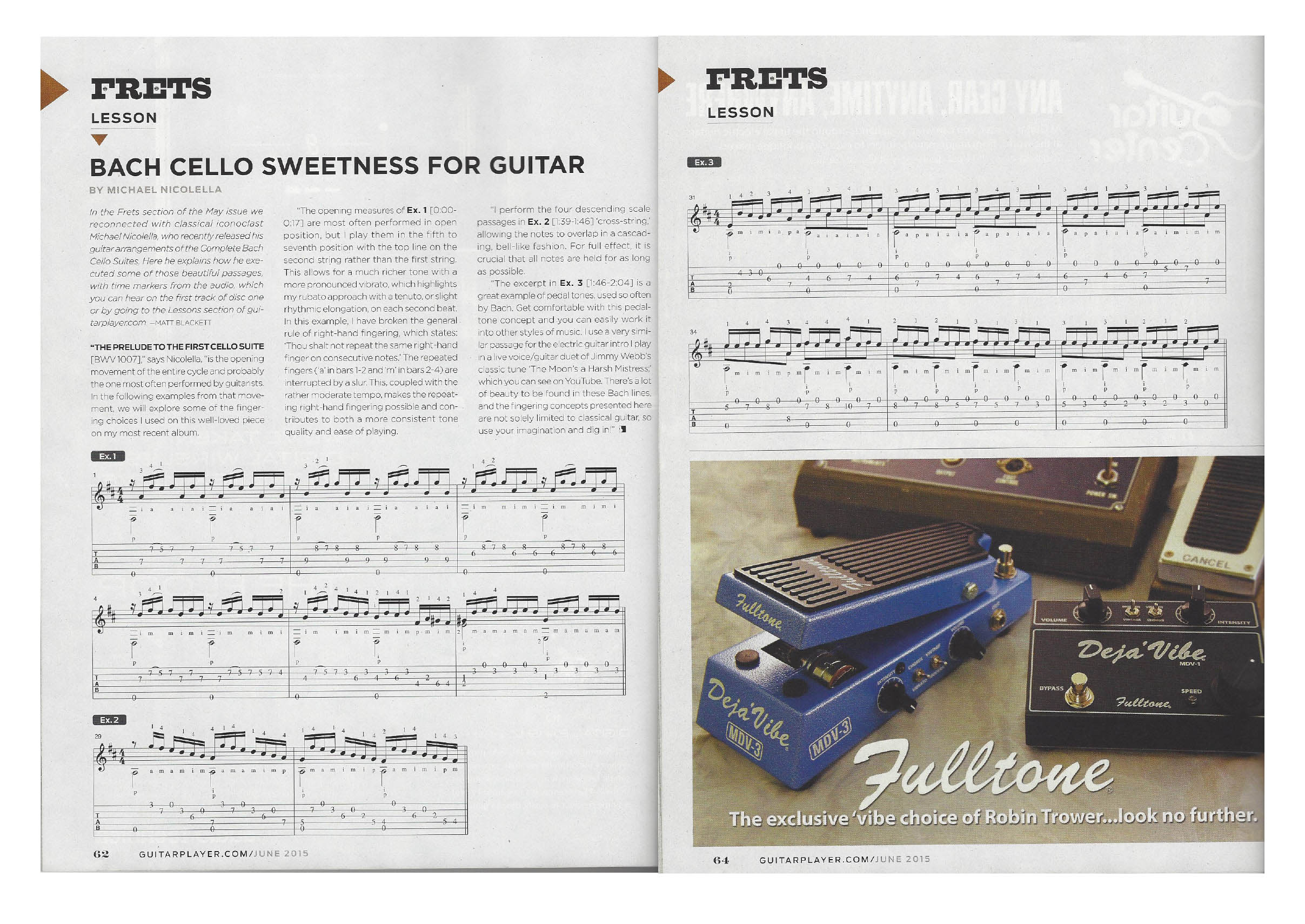

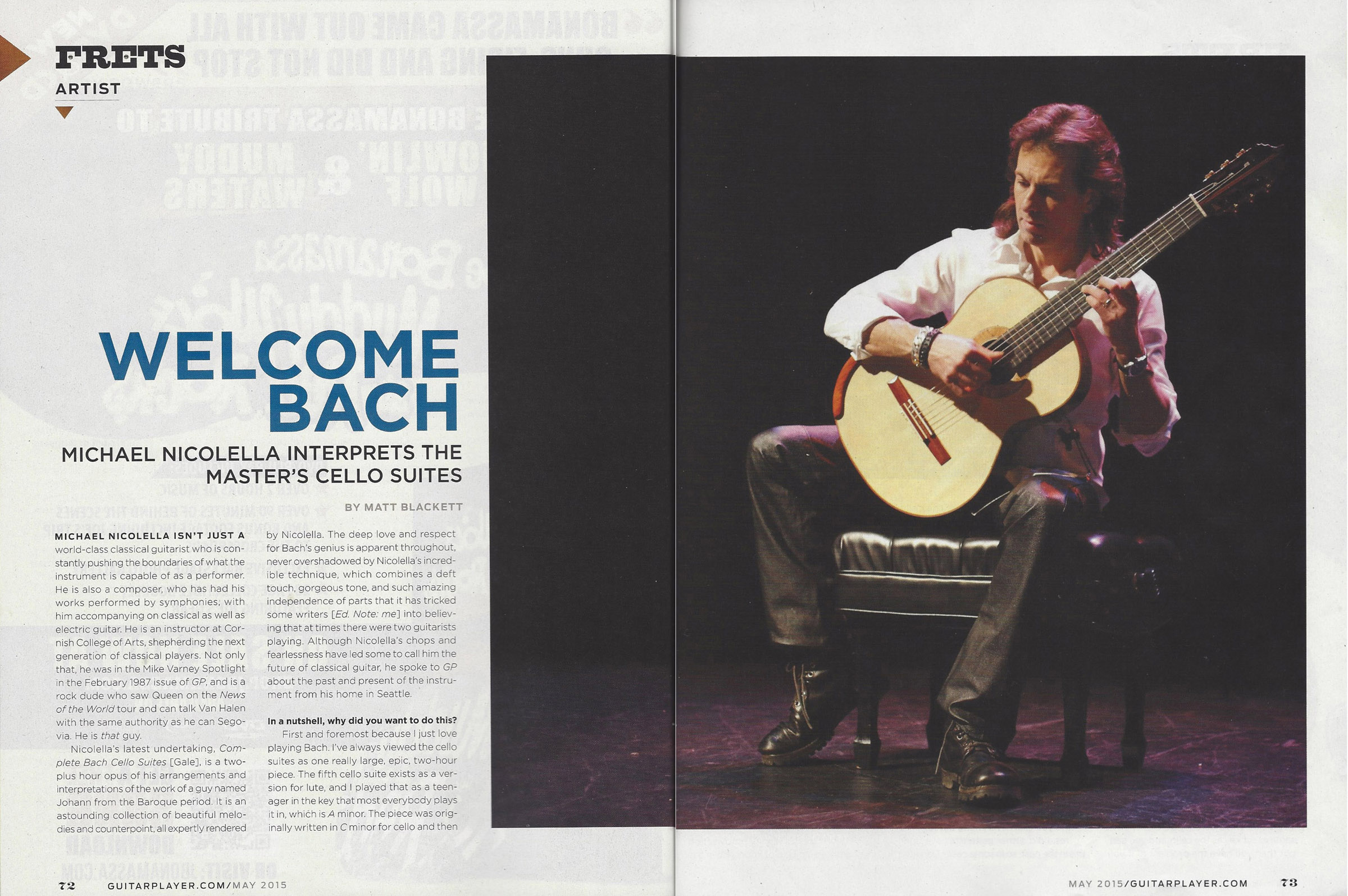
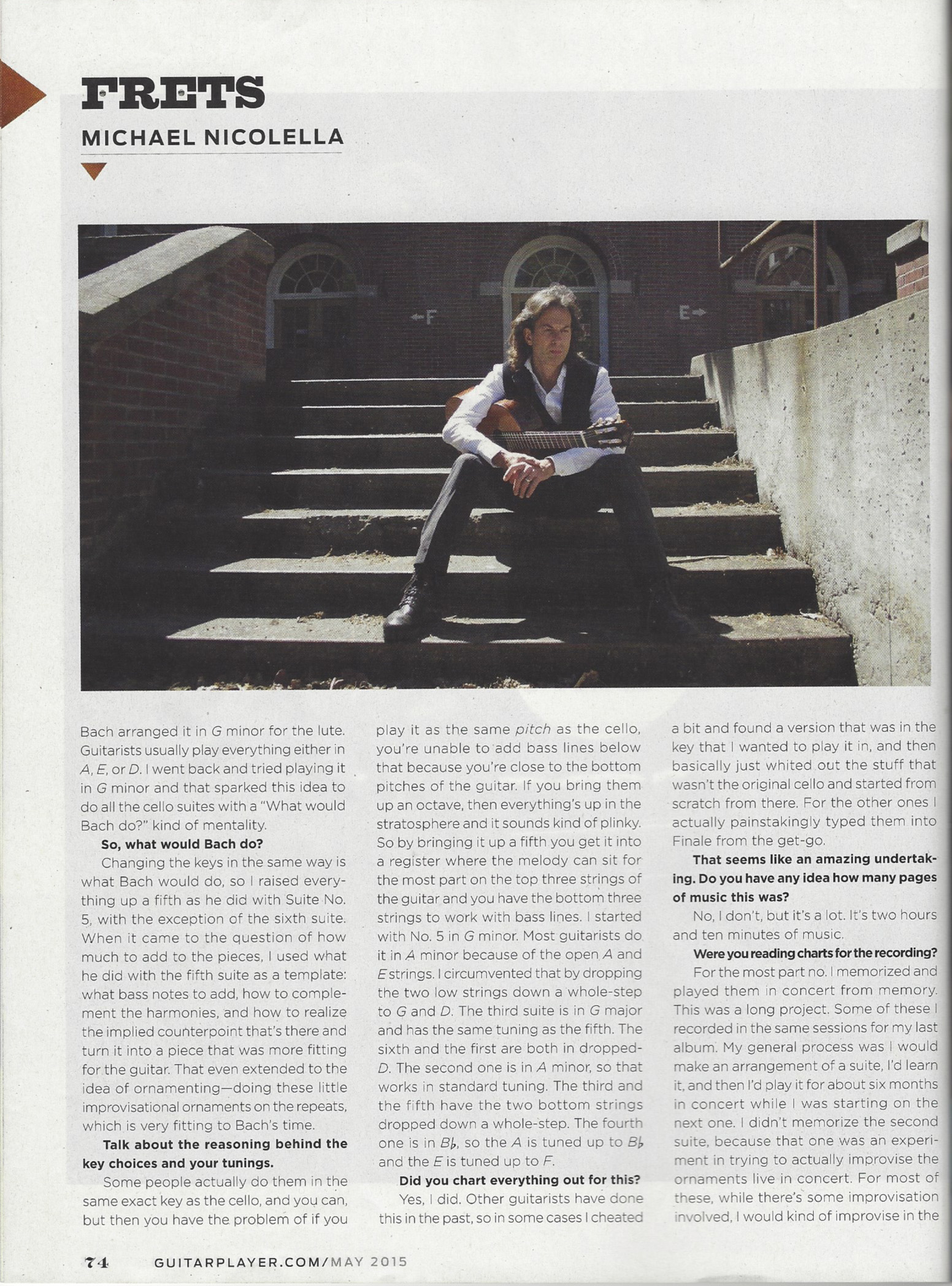
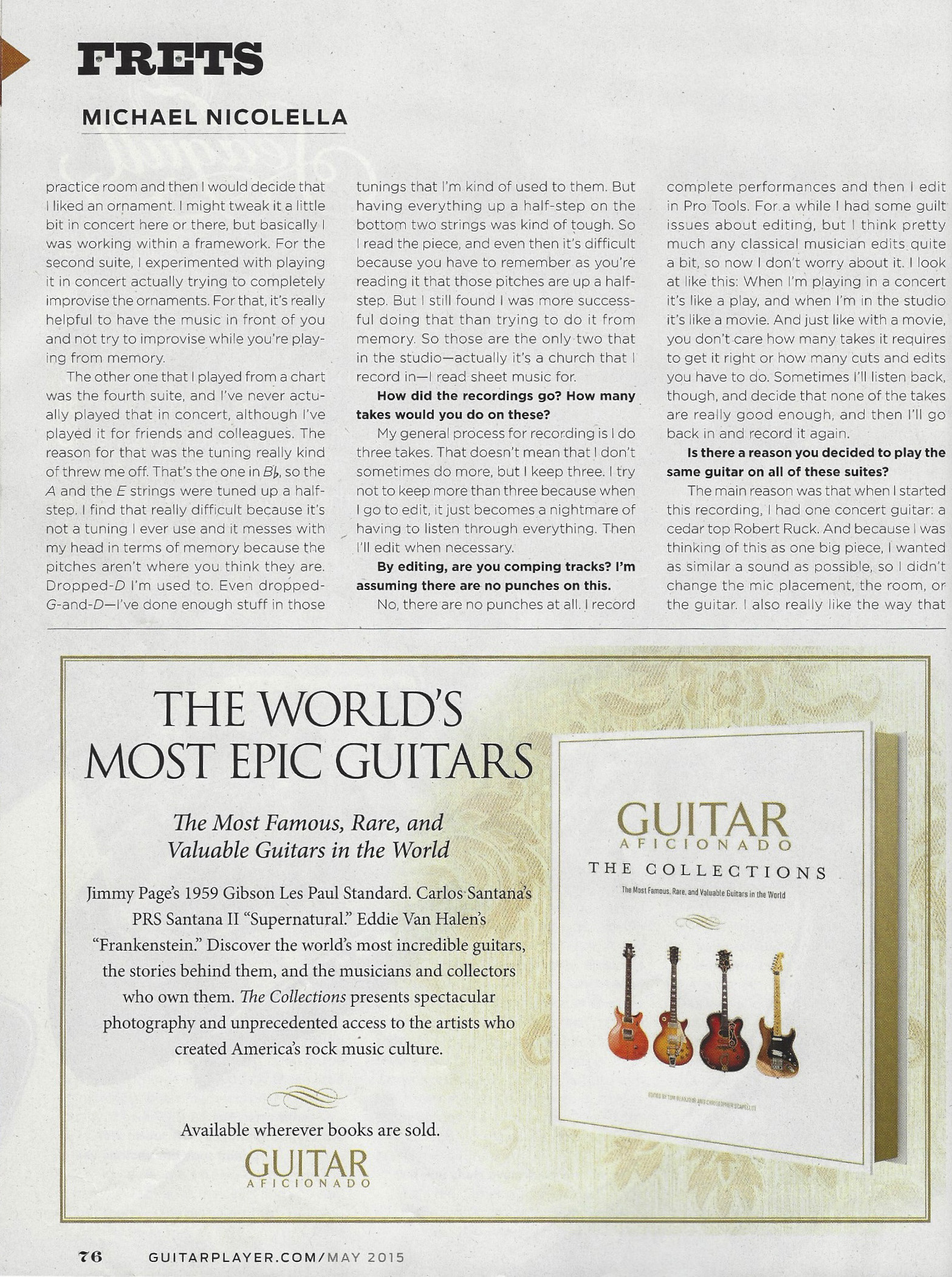
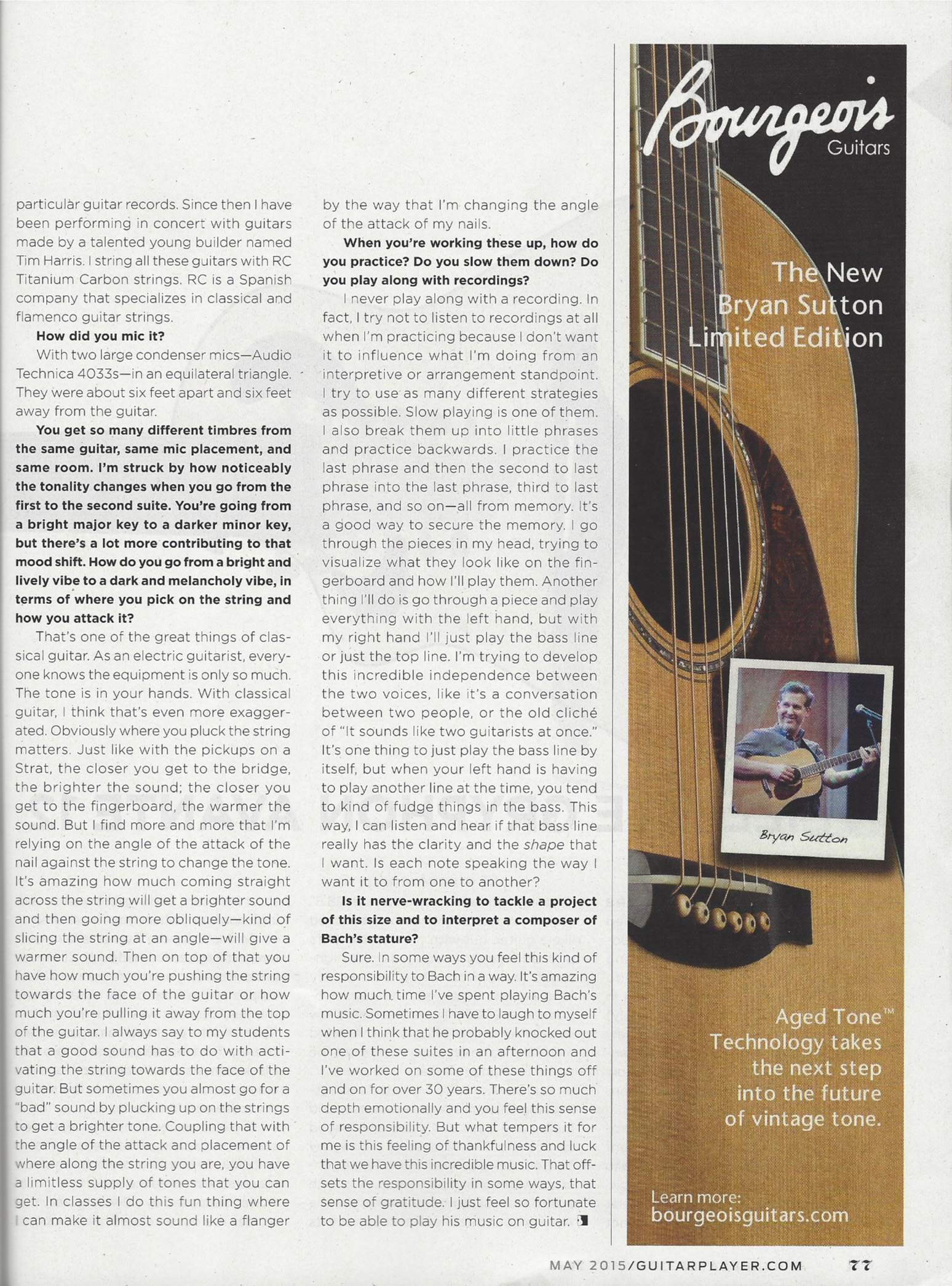

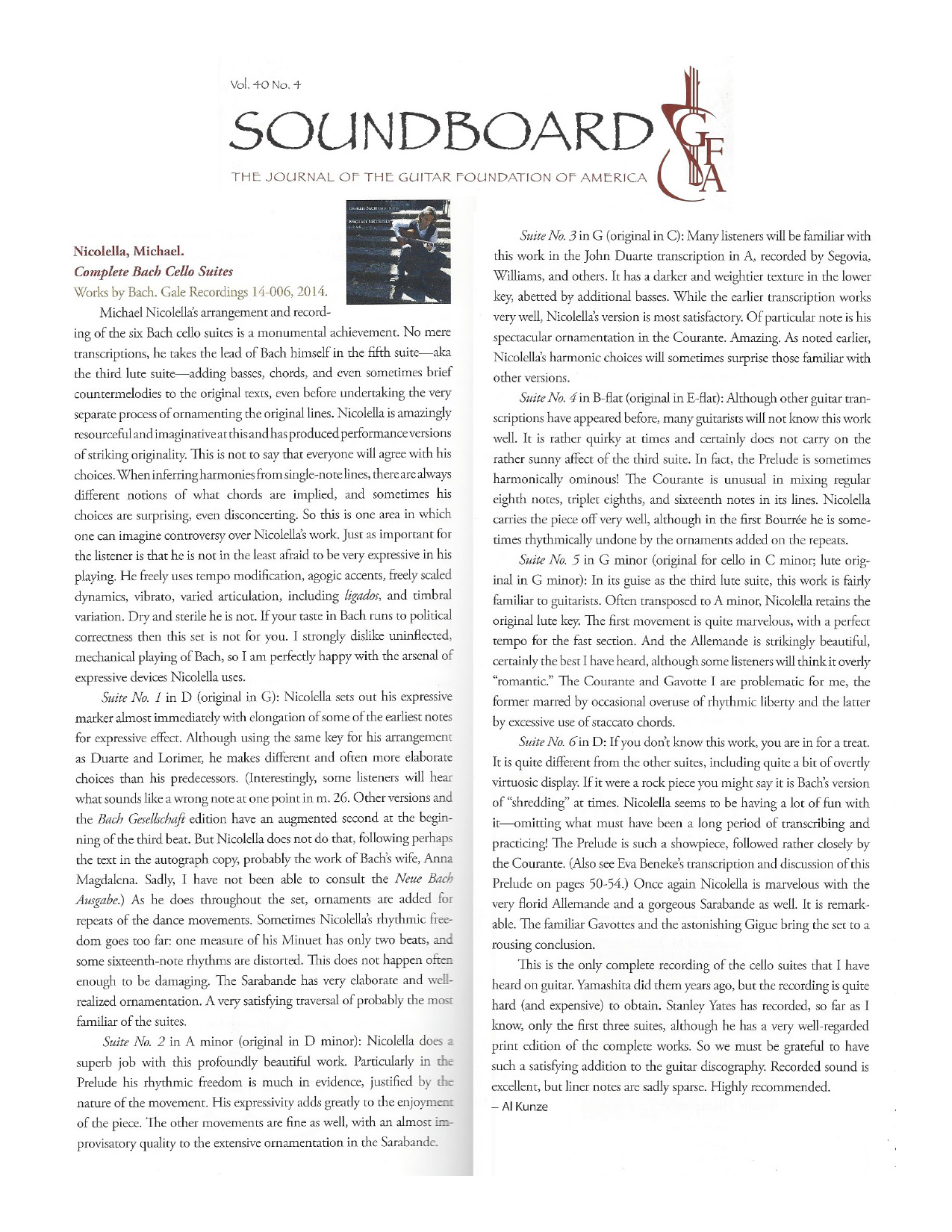
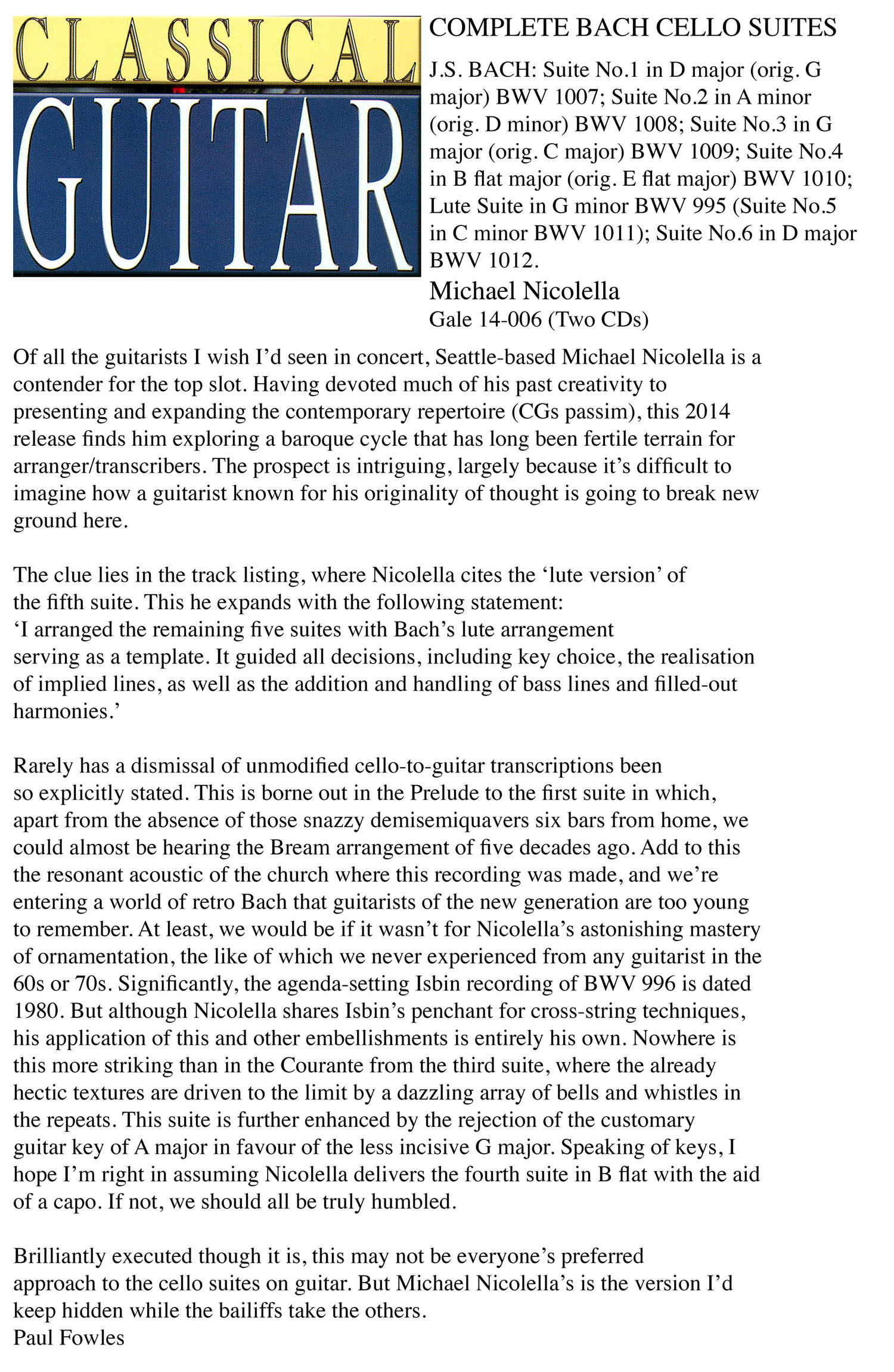
back to
top
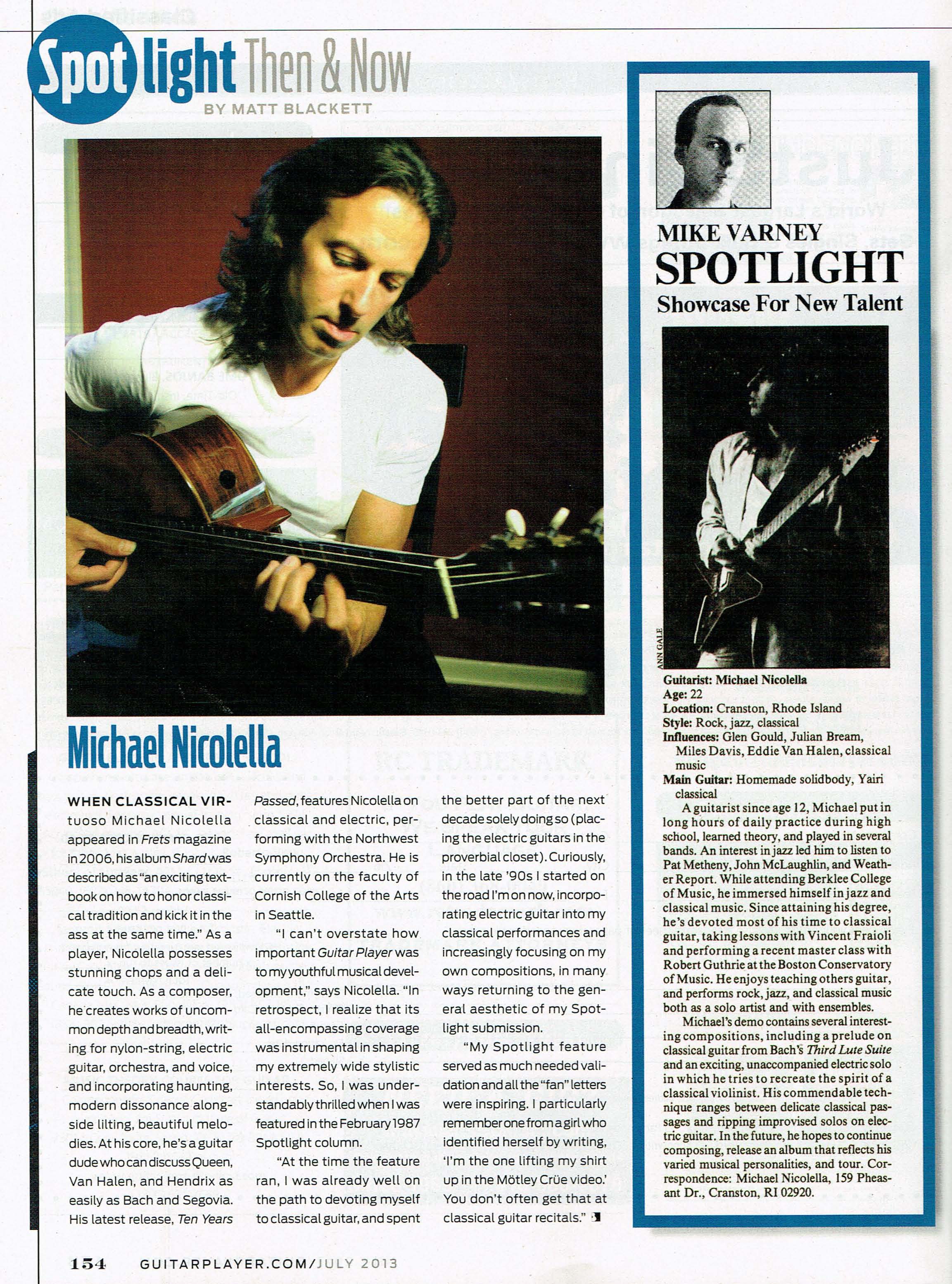
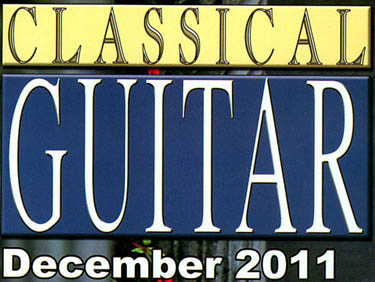
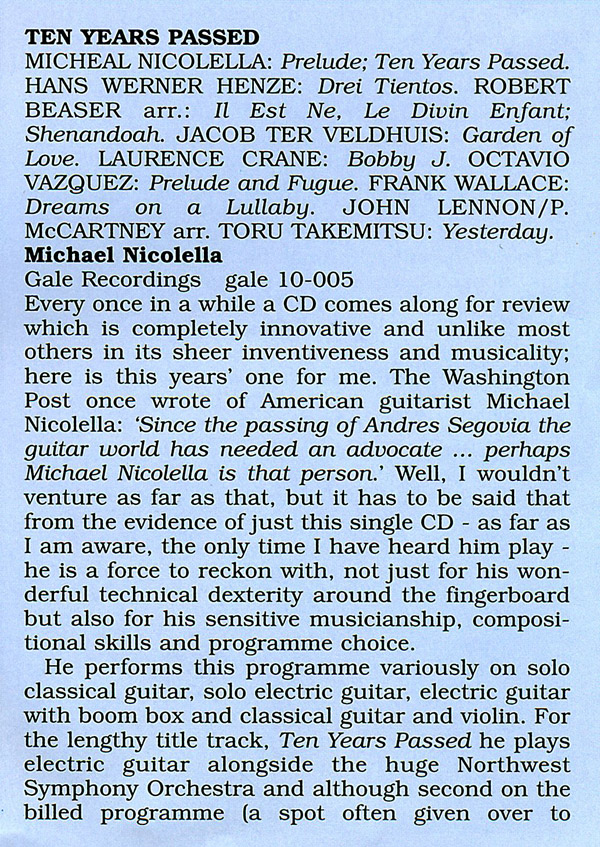
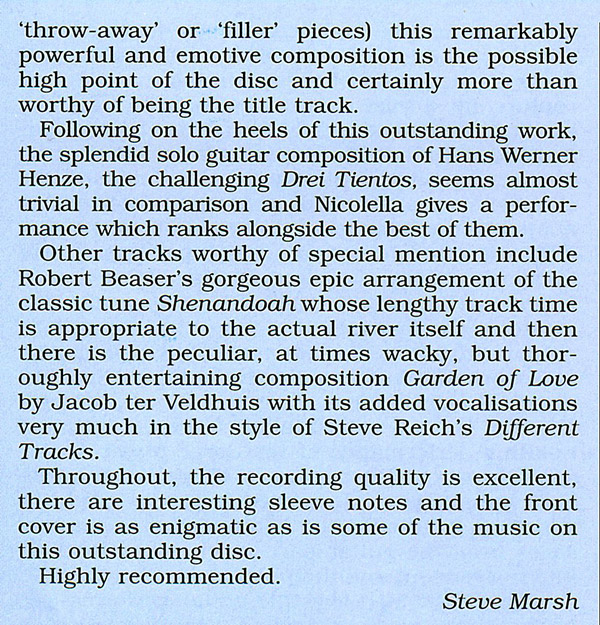

February 2009
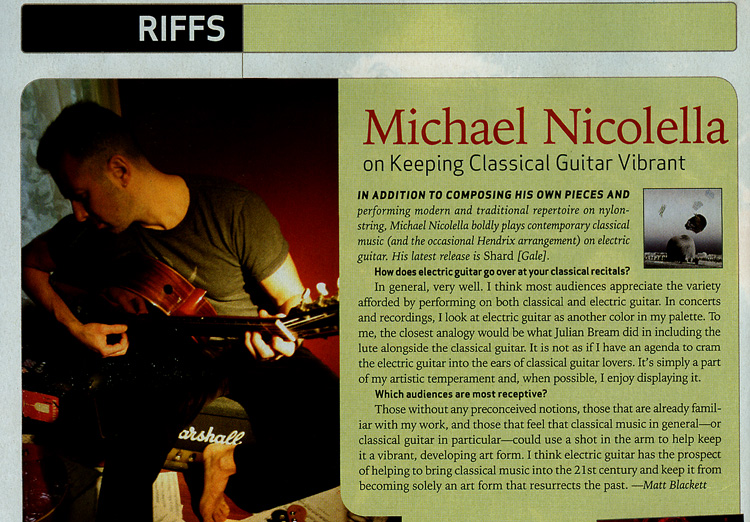
back to
top
Soundboard
Michael Nicolella. Shard.
Works by Nicolella, Reich, Carter, Veldhuis, Kohl, DeLaurenti,
Mesler. Gale Recordings: Gale 05-004, 2005. "[Includes mutimedia
works as well as guitar and orchestra. Packaging has sticker:
parental Advisory explicit Content.]
Volume 33 Nos.1&2 2007
by -Jim McCutcheon
Once in a great while, a guitar CD stands apart with sheer
creativity and musicality. Shard, Michael Nicolella's 2005
release, is a portrait of a very broadly accomplished musician with
talents in many musical areas, not the least of which is a strong
technical and expressive command of the guitar.
The opening three original works showcase Nicolella's rich
experience in contemporary music. He studiously avoids the
new-age-like repetition exhibited by guitarist/composers of lesser
abilities. Toccata and Fugue is a virtuosic solo work which
bursts with expression. The Fugue is written and performed with
excellent clarity, further developing the theme from the Toccata, a
"tip of the hat" to a well-known Bach fugue. Surfacing Through the
Mire develops a blues-influenced theme, reminiscent of the
preludes by Gershwin, and takes the development quite seriously
through frequent, effortless meter changes. As both a composer and
performer, Nicolella shows himself to be a master of portraying the
many moods of the guitar.
Written in 2002, Nicolella's Guitar Concerto consists of
four movements which flow almost seamlessly. It is clear this is the
work of a composer sensitive not only to the intricacies of writing
for the guitar but also to the use of orchestral scoring to create
new and expressive landscapes which set the stage for the soloist.
Nicolella has a mature sense of balance, using the orchestra as a
collection of chamber groups as well as a tutti con forza, passing
motives through all the instruments and writing sections for each
instrumental group. The recording quality of this piece is excellent,
with detailed balance and tone. This well-written and orchestrated
piece of music should be heard, studied, and and performed by
guitarists everywhere.
Grab It! by Jacob Ter Veldhuis presents electric guitar and
boombox, with prerecorded, assaulting, mostly unintelligible vocals
raging with raw, angry, emotional content. The few words that are
intelligible convince me that this ten-minute track should be on a
different recording. I'm just not used to classical guitar CDs
requiring a PG-13 rating.
Other contemporary works fare much better. Steve Reich's
Electric Counterpoint is vigorous and extremely clean
rhythmically; the wide variety of dynamics and textural settings is
quite joyful. The steady, minimalist ear massage using many types of
guitars makes it a lively tossed salad of guitar sound. Christopher
DeLaurenti's grey angel captures a fine spaciousness and mood
which took me to an imaginary theater with its soundtrack-like,
visual-image-evoking textures. Shard, from the pen of the
ninety-year-old Elliott Carter is given a similarly energetic and
clean reading.
Overall, this CD is the work of a serious and talented musician
who stands out in the world of clasical guitar. He is currently
involved in several creative projects, and I eagerly await where he
takes us next.
back to
top
Guitare
Classique
June/July 2006
Francois Nicholas
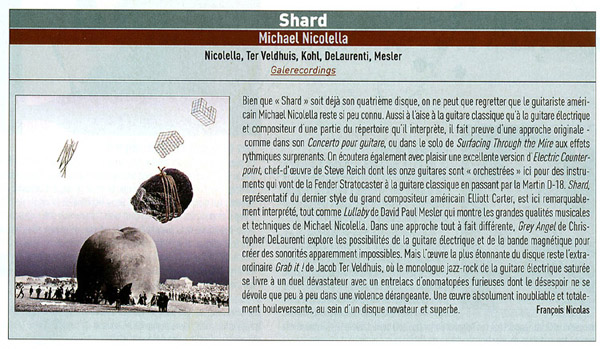
Given that Shard is already his fourth disc, it is regrettable
that American guitarist Michael Nicolella is not better known.
At ease with classical guitar and electric guitar and as a composer
of some of the material he interprets, he gives proof of an original
approach - as in his "Concerto for Guitar" or in his solo piece
"Surfacing Through The Mire" with its surprising rhythmic
effects. One is equally pleased to hear an excellent version of
"Electric Counterpoint," Steve Reich's masterpiece, in which eleven
guitars are "orchestrated" here with instruments ranging from a
Fender Stratocaster through a classical guitar and including a Martin
D-18. "Shard," representing the later work of the great
American composer Elliott Carter, is remarkably interpreted here,
much as "Lullaby" by David Paul Mesler which displays Michael
Nicolella's great musicality and technique. In a completely
different approach, "Grey Angel" by Christopher DeLaurenti explores
the possibilities of the electric guitar and tape to create seemingly
impossible sonic textures. But the most astonishing piece on
the CD is the extraordinary "Grab It!" by Jacob Ter Veldhuis where
the jazz-rock monologue of the electric guitar enriches the reading
in a devastating duel of furious interlacing onomatopoeias of
despair which reveal bit by bit a disturbing violence. This is
an absolutely unforgettable and provocative piece within a CD that is
innovative and superb.
back
to top
Frets
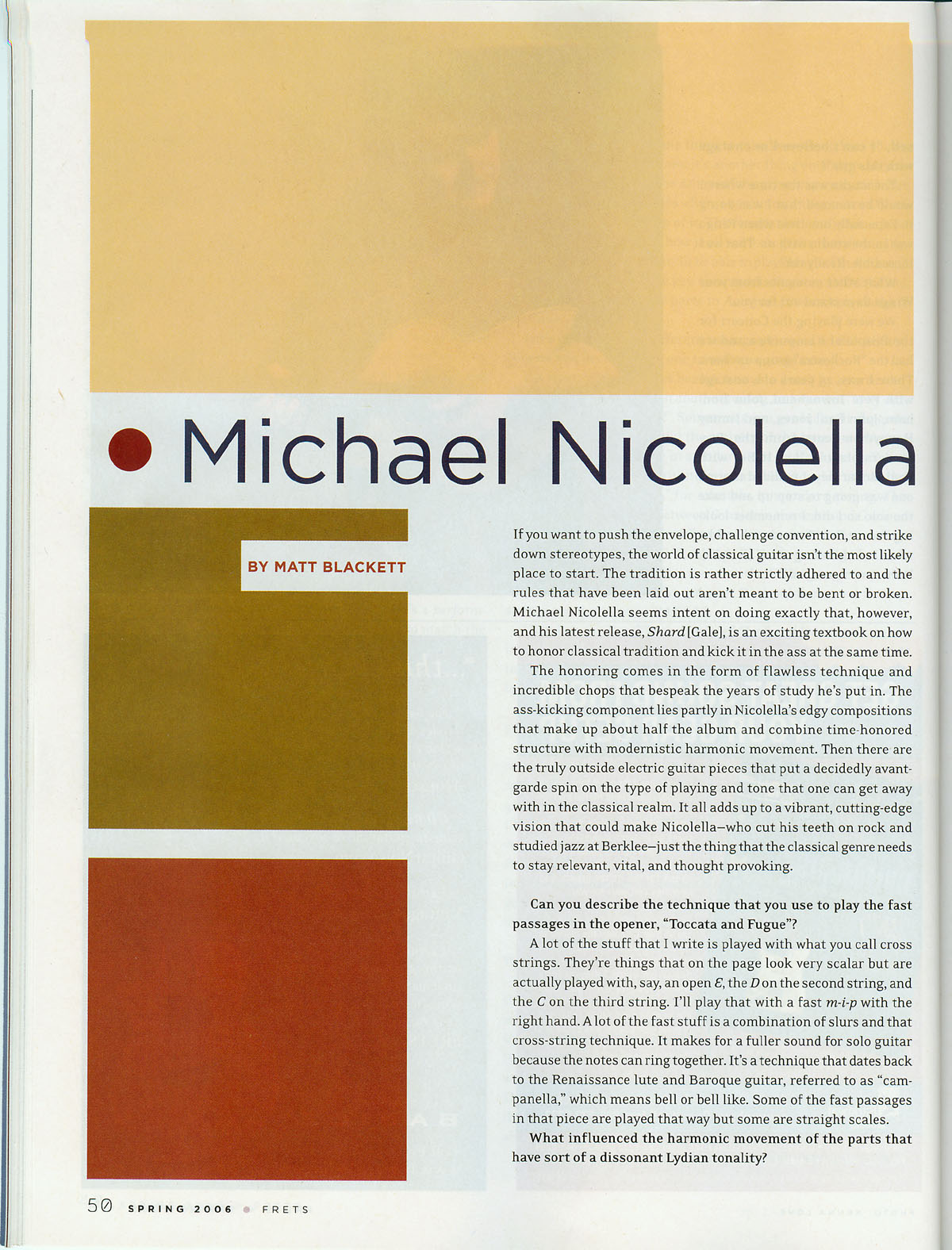
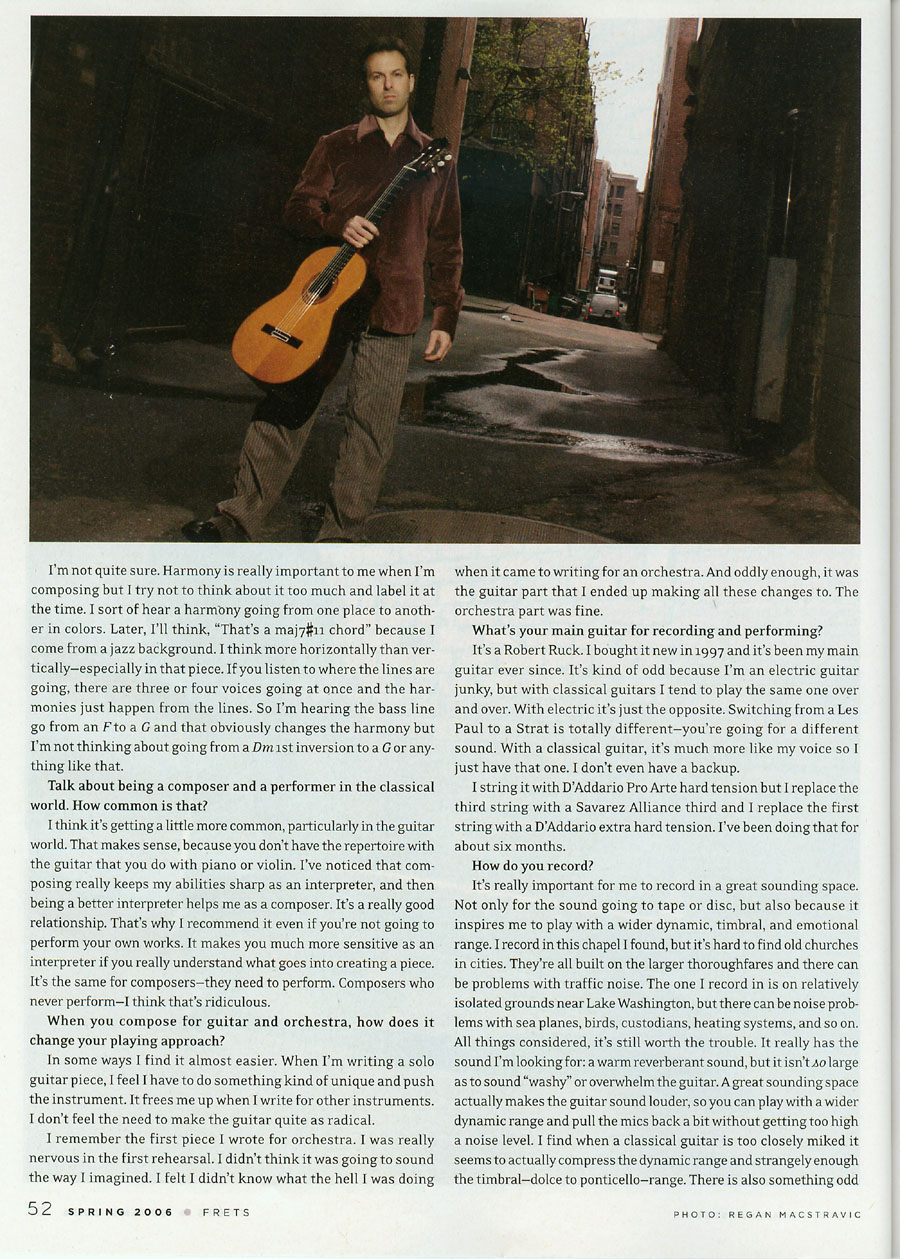
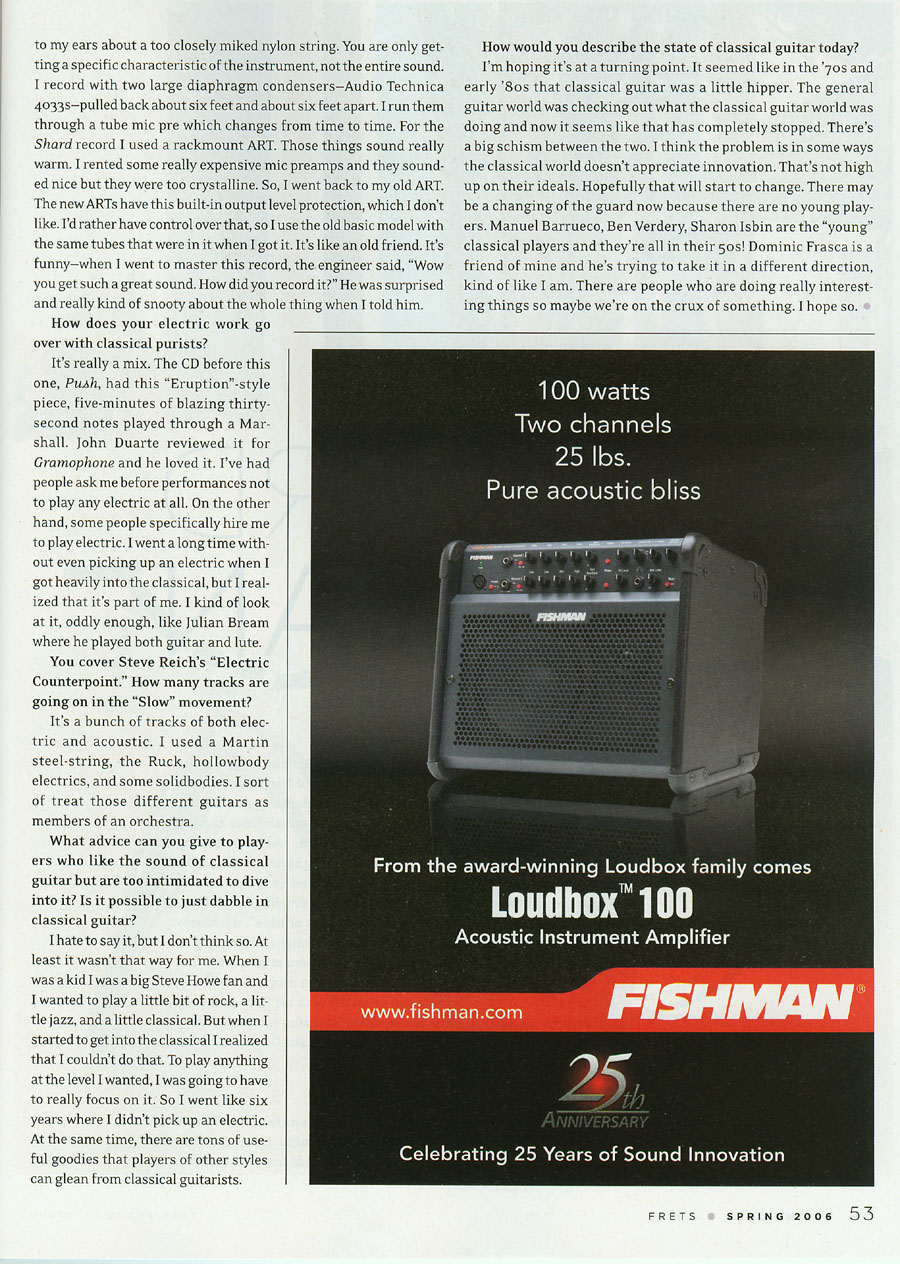
back to
top
Classical
Guitar
February 2006
by PAUL FOWLES
"Shard" Michael Nicolella with the Northwest
Symphony Orchestra conducted by Anthony
Spain
This disc represents what I suspect is a not altogether desirable
first for the pages of CG, the jewel case sporting a stern label
bearing the words Parental advisory - Explicit Content.
I'm no authority on U.S. law, but isn't this the kind of stuff
Frank Zappa was campaigning against with his Statement to Congress in
1985? But rules are rules, and the contents of this disc were
duly heard in camera by my 79-year old mother before being
unleashed on my innocent and impressionable mind. The
supposedly offending item is Grab It! by Jacob Ter Veldhuis,
which uses voice samples from prisoners serving a life sentence who,
amazingly enough, let slip the occasional coarse turn of phrase.
So if the six-year-old apple of your eye expresses a wish to
trade one of her Bratz for a Michael Nicolella CD, just say
no. But it should also be stated at the outset that Grab
It!, arranged for electric guitar and boombox from an original
for tenor saxophone and boombox, emerges as one of the most striking
items of all in this challenging but endlessly rewarding release from
one of the contemporary guitar's most gifted stars.
Starting with his own Toccata and Fugue for solo classical
guitar, Nicolella soon establishes his credentials as a composer
fully capable of negotiating the intricacies of this most exacting of
contrapuntal forms. Until the explosive chordal climax, the
language is lyrical, even retro at times. Likewise the
sumptuous four-movement Guitar Concerto, in which Nicolella in
the company of Anthony Spain and the NSO offer the premiere recording
of a work first performed in 2002. It all represents a
fulfilling and considerably less weighty agenda than what might be
feared, although the familiar textures of Electric
Counterpoint nonetheless represent a welcome breather in this
volley of new ideas.
In the suitably jagged Elliott Carter miniature from which the
disc takes its main title, Nicolella's virtuosity emerges victorious
as always in 2'29" of finger-crunching brilliance. At the other
end of the expressive dial, Joshua Kohl's Ode Tounami,
inspired by an indigenous recording from Mali, finds Nicolella at his
most restrained and spiritual. All this, together with the
cosmic electronics of Christopher DeLaurenti's grey angel and
a valedictory slice of 'straight' guitar in David Paul Mesler's
Lullaby, makes for a disc that surely bodes well for the
guitar in the 21st century and beyond.
I have yet to review a Nicolella disc without invoking the name of
his fellow Seattle luminary, a certain James Marshall Hendrix.
If the great man were around today, he would surely be urging
us to turn on to the music of such cutting-edge talents as Michael
Nicolella. If I speak less than the truth, may the spirit of
Jimi strike me down with a burning Strat...
© ASHLEY MARK PUBLISHING
back to top
Music
and Vision
Transit
A spectacular work
March 19, 2003
Post modernist music -
by REX HARLEY
'... Nicolella's tremendous virtuosity ...'
Transit is a post-modernist piece, par excellence. And if you
think that sounds a bit high-flown, wait till you read the sleeve
notes! There is only one performer involved: the remarkably
versatile, Seattle-based guitarist Michael Nicolella. All other
'instrumentation' is computer generated, and programmed by the
composer, John Fitz Rogers, and, like it or loathe it, this is a
spectacular work.
On one level, the title can simply be taken to refer to the
'cross-over' nature of the music, but this is nothing like the kind
of synthesis one normally associates with the rock/classical fusion.
For one thing, the piece is more than a set of separate movements;
it's actually quite tightly constructed. For another, it's
rhythmically extremely complex in places, and harmonically
challenging. It's contemporary. It's experimental. But the liner
notes also make a point of telling us that the instruments involved
are a Gibson 'Les Paul', a Fender Stratocaster and a 1950's Guild
guitar, names that will set the hair tingling on any rock
aficionado's neck.
Be warned then. If you're a purist, you'll probably hate what you
hear; if you're musically a pluralist, especially one whose life-span
covers the '60s and '70s, you're in for a treat. Various guitar
styles are showcased, but none is a pastiche. Where I think I can
hear references to Frank Zappa, Jimmy Page, Steve Miller, Larry
Coryell, Pat Metheny and, of course, Jimi Hendrix, another listener
will no doubt find a handful of other names I've either forgotten or
don't know.
Transit begins in a deceptively soft and spacious way.
Introduction opens with a single synthesized flute, others gradually
joining to create a sound reminiscent of the glass harmonica. The
first movement proper has the guitar effectively feeling its way,
rhythmically and harmonically, against a spacious accompaniment. This
is developed in the second movement, with shifts in tempo and a sense
of developing urgency; but it is not until part four that we fully
enter the world of rock, with appropriate bass riffs and drum sounds.
Part five is jazz-rock territory and we begin to get a feel of
Nicolella's tremendous virtuosity as the guitar solo builds and
soars. Abruptly, the rhythm changes and we're enveloped by a strange
mélange of funk and heavy metal, articulated by a series of
dislocated tempi. Part seven features rapid bursts of synthesizer.
Melody sometimes emerges in snatches which, bizarrely, seem to echo
Bach, then Hindemith. The guitar work in section eight takes us back
to the tentative ground of the second movement; then we're into the
world of heavy rock once more. Section ten, the improvised guitar
movement, is perhaps the most obviously lyrical, and beautiful of the
piece. This segues into the final section, which builds to an almost
frenzied climax, and Transit ends in a sonic antithesis of its
opening bars.
It's hard to find comparisons. Pat Metheny, perhaps, in Steve
Reich's Electric Counterpoint. But that's a very stately piece
compared with this roller coaster. The closest I can think is Jan
Hammer's album from the 1970s, The First Seven Days which,
paradoxically, doesn't even use a guitar; everything is synthesized.
Perhaps there is nothing quite like it. The only way to find out is
to listen for yourself!
Copyright © 19 March 2003 Rex Harley, Cardiff, UK
back to top
Bay
Area Reporter (et
al)*
by Jason Serinus
* Mr Serinus is a syndicated music critic. This review ran in the
Bay Area Reporter - San Francisco (6/27/02), Seattle Weekly (6/27/02)
and www.hometheaterhifi.com. (In some of these publications the
review was edited)
JOHN FITZ ROGERS/MICHAEL NICOLELLA "Transit"
Gale 02-003
Performance ***** (5 out of 5 stars)
Sound**** (4 out of 5 stars)
One thing is for certain: this recording will engender strong
reactions. Some will agree with the liner notes' pretentious prose,
which suggests that this collaboration between Rogers and Nicolella
provides "an electrifying sonic network of speed and synthesis, a
forty-four minute panorama of intangible miracles." Others will find
themselves screaming at Transit's dizzying drive, at such sections as
the three and a half minute "V," which begins with programmed sounds
resembling a recording sped up half way to infinity, only to end with
Nicolella's electric guitar further hammering the point home.
In Transit, composer Fitz Rogers, showing the influence of Led
Zeppelin, the Steve Miller Band, and Jim Hendrix, weds his
computer-generated organs, pianos, drums and array of fantastic
sounds to the astounding musicianship of his chosen collaborator,
guitarist Michael Nicolella. Playing three guitars, a 1998 Fender
Stratocaster, 1979 Gibson Les Paul Custom, and 1954 Guild X-150
archtop, allied with various amplifiers and stompboxes, the
Seattle-based Nicolella is a virtuosic wonder.
Transit begins slowly, with several minutes of quasi-celestial
computer-generated sounds. Once the guitar enters, however, the mood
changes, as the conflict and chaos of earthbound existence rise to
the fore. The work is studded with frequently stunning
juxtapositions, its unapologetic commentary destined to either
enrapture or force one to run for cover while invoking the names of
Bach, Mozart and the entire Hindu panoply.
In many ways, Transit seems an appropriate commentary on life in
the 21st century. After all, in a world where Easter night channel
surfing takes you from Charlton Heston's Moses proclaiming God's
commandment, "Thou Shalt Not Kill," to fresh footage of Israeli
politicians screaming for vengeance; where George Bush, who stole the
Presidency, condemns Fidel Castro for not holding free elections, far
more than hard driving irony and Strauss waltzes are in order.
Parts of this virtual symphony seem ecstatic, others funereal. Its
pace and multi-layered chaos will either energize you or give you a
headache. Either way, or both, it must be heard.
back to top
20th
Century Guitar
August 2002
by Robert Silverstein
Transit
A flashback to key early 70's mergers of avant-garde, neoclassical
electronics and rock, the 2002 release of Transit pairs the electric
guitar work of the classically trained Michael Nicolella with the
"virtual ensemble" keyboards and programming of John Fitz Rogers. On
their superb, eleven track two part CD, Transit, Nicolella evokes the
spirit of Jimi Hendrix, while Rogers' symphonic synthesized backdrops
are the perfect foil for Nicolella's daredevil processed
guitarscapes. Someone said it sounded like Conlan Nancarrow meets
Steve Hackett and as such should be filed under modern instrumental
music as played by rock musicians. For another side of Nicolella
check out his two classical guitar albums Push and Bach, Britten,
Martin
back to top
ProgressoR.net
May 21, 2002
Vitaly Menshikov
Six out of
six stars "masterpiece"
back to
top
Seattle
Times
May 05, 2002
By Melinda Bargreen
Seattle Times music critic
"Transit,"
new music of John Fitz Rogers, with Michael Nicolella, electric
guitar (Gale Recordings).
Michael Nicolella, a Seattle
guitarist most classical fans will know best for his acoustic work,
takes on a huge project here: the new, 11-movement "Transit" by John
Fitz Rogers for electric guitar and "virtual ensemble" (i.e.,
synthesizers/computers). Categorizing this piece, and this
performance, is next to impossible; it's a synthesis of classical,
rock, jazz and all sorts of other elements.
Even from this writer's firm
bias for acoustic instruments, the array of sounds here is amazing,
from the pliant flutes of the opening through a virtual orchestra of
keyboard, percussion, wind and other computer-generated sounds.
Nicolella's guitar, especially in the two lengthy improvisational
sections, is given a virtuoso turn that transcends the usual
limitations of that instrument.
back to
top
Sequenza
21/
The Contemporary
Classical Music Weekly
June 24 - July 1, 2002
Transit Composer: John Fitz
rogers, Electric guitar: Michael Nicolella
A single 44-minute work with the architecture of
classical music but the drive of rock. Intense ambient masterwork
that weaves classical, jazz, pop and rock into one fantastic musical
tapestry. Gorgeous playing by Nicolella, a guitarist with lots of
talent and technique.
back to
top
Gramophone
April 2003
by John Duarte
"Push" Michael Nicolella
A highly eclectic programme
presented by a highly accomplished guitarist
Michael Nicolella began as a jazz guitarist,
transferred his affections to the classic instrument and now applies
his skills to both in due turn. Others have 'crossed the track' in
one direction or the other but none has done so with the technical
and/or musical success as Nicolella, who,chameleon-like, achieves
comparable distinction in both fields. I can think of no-one else who
could juxtapose such disparate pieces as Berio's SequenzaXI
and Jimi Hendrix's Little Wing at the end of his programme and
still be 'heard' as two different players of outstanding quality.
Much is owed to the sagacity of his approach to
the classic guitar. Instead of seeing it merely as an alternative
medium for jazz he embraced it and its music as 'anotherworld',
bringing with him an open musical mind and the well-developed
left-hand technique of a jazz guitarist. He studied with famous
teachers of the classic instrument, and still keeps the two musical
areas firmly compartmented.
What is there to be said of a record whose
programme is redolent of a salesman who empties his bag on ones
doorstep, with items (not least Rogers'breathless Push) that will
frighten the average classic-guitar lover, and others may try the
patience of the devoted jazz buff? It is hard to decide at whom this
remarkable disc is aimed, but I recommend it to all whose minds are
open to a display of stunning technical skill and unfailing
musicality over a very broad spectrum. Those who insist on putting
things into pigeonholes will have a hard time with it!
back to
top
Classical
Guitar
December 2000
by Paul Fowles
"Push" Michael Nicolella
A useful indicator of the guitar's development over the last few
decades is the state of the debut recording. Not that long ago, young
hopefuls would display their skills via a mainstream program
containing at least one major work, usually the Bach Chacconne, and
one new contemporary work, usually commissioned by or dedicated to
the performer.
This remarkable release from Seattle-based Michael Nicolella shows
how times have changed. The Piazzolla notwithstanding, Nicolella's
uncompromising choice of material never once loses the momentum
established at the outset by Sierra's brilliant Toccata y
Lamento.
The very presence of Berio's Sequenza XI is sufficient to ensure
Nicolella's arrival will not go unnoticed. Although it is a work
which tends to be esteemed rather than enjoyed, the very state of
having recorded it can seriously further your career.
However, it is in John Fitz Rogers' eponymous Push for solo
electric guitar that one becomes fully acquainted with the diversity
of Nicolella's talent. In 5'20" of breathtaking heavy rock
pyrotechnics, we find ourselves a long way from the days when
classical guitarists would dip a toe into popular music by presenting
some third party's intractable settings of Gershwin and Cole
Porter.
Elsewhere, Nicolella is joined by a supporting cast of chamber
musicians and a singer for the Berio arrangement and his own
contemplative Bridges. The inclusion of this work together with the
Three Brief Episodes for solo guitar, is significant. For much of the
twentieth century the guitarist/composer was an endangered species,
and it is with much relief that the likes of me are now able to issue
regular bulletins on its global renaissance.
But all of this would be of little worth if it were not for the
fact that Michael Nicolella emerges as a superb all-round guitar
player whose dynamic and engaging performance shows him to be more
than equal to the challenges he has set himself.
Nicolella finally takes up his '98 Strat for a wonderfully
evocative, and dare I say it, nostalgic account of Little Wing, the
sincerity of which is illustrated by his unconditional statement that
'...Jimi Hendrix will prove to be one of history's most important and
influential guitarists.'
There speaks a fully enlightened musician of our time.
back to top
Hartford
Advocate (et al*)
by Jason Serinus
* Mr Serinus is a syndicated music critic. This review ran in the
Hartford Advocate(4/26/01), East Bay Express - San Francisco
(5/24/01), Seattle Weekly (7/12/01) and www.hometheatrehifi.com. (In
some of these publications the review was edited)
MICHAEL NICOLELLA PUSH Gale 00-002
Performance ***** (5 out of 5 stars)
Sound**** (4 out of 5 stars)
From the first driving notes of Roberto Sierra's Toccata y Lamento
(1987), Seattle-based classical guitarist Michael Nicolella, a first
prize winner in several solo classic guitar competitions, impresses
with his virtuosic musicianship. Equally impressive is Nicollela's
immensely challenging modern program for acoustic and electric
guitar, which pushes the boundaries of what one might consider
technically playable.
The disc Piazzolla's captivating Primavera Portena ((1970),
Takemitsu's Equinox (1993), Jimi Hendrix's Little Wing (1967), John
Fitz Rogers' Push (1997 - written for Nicolella), two of Nicolella's
own compositions, plus works by Berio, Bryan Johanson, and Richard
Kranjac. Nicolella's Bridges (1990) for flute, violin, guitar and
percussion is an especial wild and beautiful ride. Another highlight
is the wonderful soprano Thomasa Eckert's rendition of Berio's
chamber arrangement of the traditional "Black is the Color of My True
Love's Hair," her voice triumphing over an over-resonant acoustic to
perfectly capture the innocence and purity of the verse. Berio brings
a very different consciousness to this folk song than did Britten to
his folk song arrangements.
When I shared Rogers' driving, mile a minute, machine gun-like
Push with eight-year old Morgan Saltz, she smilingly confided that it
made her feel "excitement…like turning somersaults in my
stomach." After playing Berio's challenging Sequenza XI (1988), whose
uncompromising atonal outbursts, punctuated by hard raps on the
guitar's body, may remind you of neighbors banging on the door,
shouting "Turn down that infernal racket," I told her that some might
not consider it music. "Why?," she asked with puzzled countenance.
"It has rhythm, it has melody - why would anyone say it's not
music?"
After Berio and Rogers, Jimi Hendrix's contribution seems mellow
indeed. With blessings to the young, I highly recommend this disc to
music lovers with open minds and a taste for adventure.
back to
top
Milwaukee
Journal Sentinel
Sunday, January 7, 2001
by Tom Strini
Journal Sentinel classical music critic
Classical guitarist Michael Nicolella,
"Push," (Gale Recordings 00-002)
Michael Nicolella taught at the Wisconsin Conservatory of Music
and Lawrence University from 1991-'95, while his wife, painter Ann
Gale taught at the Milwaukee Institute of Art and Design. They now
live in Seattle.
In his Milwaukee days, Nicolella played with a lofty objectivity
underscored by repertoire choices - lots of Bach. The pristine
clarity of his sound remains on this new disc. Even under the
scrutiny of close miking, his playing is free of clicks, buzzes and
muffles.
The great discovery here is a new level of intensity. The higher
temperature matches the repertoire: "Toccata y Lamento," a furious
workout by former Milwaukee Symphony resident composer Roberto
Sierra; "Primavera Porteno," a profoundly despairing tango by Astor
Piazzolla, in Nicolella's penetrating arrangement; Berio's Sequenza
XI and "Black is the Color"; Takemitsu's enigmatic "Equinox"; Richard
Kranjac's "Tales of Velocity and Abandon"; Bryan Johanson's driving
"Open up your Ears": and John Fitz Rogers' rock-god rave-up, "Push"
for electric guitar.
On the gentle and contemplative side are Nicolella's own "Bridges"
and "Three Brief Episodes," and Jimi Hendrix's soulful "Little Wing,
" which is also played on electric guitar.
This engaging, intriguing, wide-ranging music makes me glad that
Nicolella has strayed from the beaten path. The command and flair
that he brings to it affirms what I thought when I first heard him
ten years ago: Michael Nicolella could become one of the very
best.
back to top
Guitar
Review
2001 (#121)
by Stephen Griesgraber
"Push" Michael Nicolella
Michael Nicolella's most recent release contains only two of his
own works, but one of these, Three Brief Episodes, displays
such a rare beauty that it had to be mentioned here. The liner notes
say that this piece was inspired by Webern, George Jones, and
Soundgarden. These seemingly disparate influences are brought
together to create a work that sacrifices nothing in its brevity, has
an uncommon melodic grace, and still moves with depth and energy.
In addition to Nicolella's own compositions, the disc features
premiere recordings of a three movement solo guitar piece by Richard
Kranjac, and the title track Push for solo electric guitar by
John Fitz Rogers. Also included are Takemitsu's Equinox,
Berio's Sequenza, an arrangement of Berio's arrangement of
Black is the Color, and a solo electric guitar performance of
Hendrix's Little Wing. All tracks feature Nicolella's solid,
robust and confident commanding technique. For a recording to feature
original compositions, premieres, electric guitar performances,
chamber works and established master pieces of the contemporary
repertoire, is truly unique. It should be a welcome addition to the
collection of anyone interested in new directions for the guitar.
back to
top
Soundboard
Winter/Spring 2001
by James Reid
"Push" Michael Nicolella
Seattle guitarist Michael Nicolella is clearly a guitarist at ease
with contemporary music, and this ease is ably demonstrated in this
very eclectic release. The recording includes works for solo guitar,
chamber music including guitar, and two tracks played on electric
guitar. Initially, it is jarring to hear the electric compositions
included here, because the sound is so unlike the classical guitar.
But the title piece, "Push," aside from the sound quality, shares
some of the same charecteristics as other tracks on the CD.
Nicolella has an affinity for pieces that are virtuosic, as
evidenced by his inclusion of Berio's Sequenza XI. He plays this very
demanding piece with great conviction, never shying away from the
daunting requirements that the piece makes on a performer. There are
also many lyrical moments on this recording in which Nicolella
demonstrates a sensitive side to his persona. In particular I was
taken by his performance of the Berceuse by Richard Kranjac and the
Berio arrangement of "Black is the Color." Fittingly, the recording
concludes with a tribute to another Seattle guitarist, Jimi Hendrix.
This is a more gentle treatment than Stevie Vaughn's, for example,
but it is effective nevertheless, and it makes for a very satisfying
conclusion to a very convincingly played program.
back to top
The
Milwaukee Journal
Sunday, July 25, 1993
by Don Lewis
Journal Reviewer
"Bach, Britten, Martin" Michael Nicolella
(Gale 92-001)
The temptation was irresistable. halfway through guitarist Michael
Nicolella's recording of Bach's Ciaccona (from the violin partita BWV
1004) I had to put on Andres Segovia's recording of the same piece.
It was a terrible mistake: I don't even think I'll ever listen to the
Segovia version again. aside from the awful quality of the recording
itself, the Segovia performance lacks the clarity of line, the
overall concept that Nicolella brings to this 12-minute work.
Providence-born Nicolella, a graduate of Yale and Berklee, lives
in Milwaukee now and is on the faculty of the Wisconsin Conservatory
and Lawrence University. He is a major addition to our town's music
scene as is amply evident in this, his debut recording.
Included are Bach's "Prelude, Fugue and Allegro", BWV 998; Frank
Martin's Quatre Pieces Breves; the Bach Ciaccona and Benjamin
Britten's Nocturnal, Opus 70. Nicolella essays this varied batch with
a facility of technique that is amazing. it's just plain fun to hear
the dynamic and textural shadings he can bring to the often moody,
introspective Martin pieces, for examle.
The Bach is beautifully played. Nicolella knows the value of the
spaces between notes, the split-second intervals that give each note
time to sound. He uses those tiny spaces masterfully.
Britten's Nocturnal is actually a set of variations on a theme by
John Dowland, with the theme not stated until the end of the piece.
Nicolella essays these brief, pithy pieces, titled "Musingly,"
Restless" and so forth, with high virtuosity. This is classical
guitar at its best.
back to top
Soundboard
Winter 2009
by Mark R. Switzer
GFA 2008
Michael Nicolella played the 11:00am concert and did a
beautiful job performing some old warhorses and some new pieces.
He began with Giuliani's Andante Sostenuto, Op.106,
No.1; Scarlatti's Sonata in E major, K.380 and his own
compositions, Surfacing Through the Mire and Toccata and
Fugue. He then switched from classical guitar to electric
guitar and played Jacob ter Veldhuis's Grab It! for electric
guitar and boombox. This, he followed with his rendition of Hendrix'
Little Wing and, for an encore, Takemitsu's arrangement of
McCartney's Yesterday - very beautifully played indeed.
back to
top
The
State
Simplicity of classical guitar complements
adventurous electronic concert
February 3, 2007
By GREGORY BARNES
You can appreciate Beethoven and Brahms even if you don't know the
difference between a crotchet and a quaver. But can you appreciate
electronic music pioneer Paul Lansky if you don't know the difference
between stochastic processes and granular synthesis?
Heck yeah!
Lansky wrote, "Music succeeds when its machinery is less
interesting than its tunes." That was exactly the case in his
"Dancetracks," opening the latest USC Southern Exposure program,
"Exposed Wiring III," Thursday night.
A computer-generated drum track bopped along quietly as guest
soloist Michael Nicolella brilliantly improvised on electric
guitar.
"A Guy Walks Into a Modal Bar" was worlds away: computer-generated
multi-channel audio built on endless marimba-like resonances in
360-degree surround-sound.
"A is for ..." eschewed computers in favor of a USC faculty
chamber ensemble, speaker (human, that is) and video.
Two other Lansky works, "Aimless Air" and "Crooked Courante," were
for Nicolella's gorgeous-toned, un-amplified classical guitar, and in
that simplicity was the greatest beauty of the evening.
A close second was Nicolella's own composition, a vivid toccata
and subtle fugue, played with impressive technique and incredibly
clean articulation.
Lansky was in the audience (standing-room-only, as usual) and
chatted about his music in a warm, self-deprecating manner, belying
his extensive musicianship and computer-programming prowess. He runs
the Princeton University electronic music project, and yes, that's
the home of the geek-revered "Laptop Orchestra."
Reginald Bain gave the first performance of "The Music of the
Primes" for laptop (Macintosh, of course). Bain created it at xMUSE,
the School of Music's Experimental Music Studio. He explained how
prime-number rhythmic sequences and layering at different tempos
became the musical language of the composition.
Nicolella brought the esoteric evening to an electric-guitar close
with Jimi Hendrix's "Little Wing." There's no question that Nicolella
is a superb guitarist, hugely successful in traditional and crossover
music.
The electronic music was heard on a spectacular sound system
designed by talented USC techie Jeff Francis.
The Southern Exposure New Music Series, directed by John Fitz
Rogers, recently was awarded the 2007 Chamber Music America/ASCAP
National Award for Adventurous Programming.
It isn't hard to see why.
Barnes, a violist, is a former member of the Virginia and Atlanta
Symphony Orchestras, a conductor of youth and adult orchestras, and a
visiting lecturer at USC.
back to top
The
Columbia Free Times
November 19, 2003
by David Lowry
The Guitar Reigns under Nicolella
This is a review of a solo guitar concert by Michael Nicolella
held Nov. 14 at the USC School of Music Recital Hall as part of the
Southern Exposure New Music Series.
The guitar, often much maligned, is one of music's most amazing
instruments. Like its many close cousins Ð sitars, lutes,
ukuleles, etc. Ð and its distant cousins, the stringed keyboard
instruments, it has the limitation of a tone immediately decaying
after being struck. Novice players drive one up the wall. Artists,
however, can convince their mothers that guitars can play legato
lines and pronounce words.
Michael Nicolella walked into Columbia on Friday night and made it
clear that he can fool mother and make a major violinist jealous.
Nicolella has been called the successor to Andrés Segovia, who
may be the éminence grise of modern guitarists, but who never
had to face the 21st century. Nicolella knows he is at the forefront
of the profession in his day, and he loves it. So did the
over-capacity audience.
Nicolella opened with an innocent acoustic piece by Manuel Ponce,
easing into the performance as he sensed the acoustics of the room
and the smell of the crowd. Then he went straight into a 1971 Cuban
work by Leo Brouwer that took the audience back to the pre-Star Wars
era. Particularly moving was the ambiance of the composer's isolation
from the free world. How can an acoustic guitar produce such
incredible space-age sounds without electronics? Answer: put it under
the hands of a virtuoso musician who understands the age and the
instrument. Nicolella has it.
American Steve Reich's Electronic Counterpoint achieves in
20th-century terms what Wagner achieved in great chunks of his
19th-century music Ð making the clock stop. The repetition of
musical fragments and textures (please don't call it "minimalist")
literally makes one lose all sense of time. This work requires
electric guitar and prepared tape in a three-movement work that ends
with the insistent, mesmerizing kind of music that Reich's 1988
Different Trains exhibits. You simply don't want to get off that
train.
The second half of the program included a piece by Southern
Exposure's artistic director, John Fitz Rogers, a 1997 piece called
Push. This is classic virtuoso music for the electric guitar, played
by the virtuoso for whom the work is written.
The final work on this masterful program required tenor sax,
piano, marimba and electric guitar. Louis Andriessen's Hout (Dutch
for "wood") is a chase of fascinating musical fragments in four-part
canon, with the three guest performers from the School of Music
rising to a level consistent with the guest artist.
The concert was free, and it was a whale of a lot better than some
of the things for which we pay. Ð David Lowry
back to top
The
Seattle Post-Intelligencer
Tuesday, June 11, 2002
By R.M. CAMPBELL
SEATTLE POST-INTELLIGENCER MUSIC CRITIC
"Guitar society closes season on a diverse and
superb note"
The Seattle Classic Guitar Society has been bringing the creme de
la creme of the guitar world to its home base for more than 40 years.
But it has not neglected those who chose to live here.
Michael Nicolella, who closed the 2001-02 season this weekend at
Nordstrom Recital Hall, is one example. A graduate of such
prestigious schools as Yale, Berklee College in Boston and Accademia
Musicale Chigiana in Italy, Nicolella has received a number of local
fellowships and grants and tours widely, Old World and New.
Judging from his recital on Saturday, Nicolella wants to be an
artist of the moment, a noble and worthy ambition. Several works had
close connections to the guitarist. In some cases he commissioned
them and in others he played the premiere. Christopher DeLaurenti's
"Grey Angel," for instance, was given its first outing this weekend.
Nicolella is a guitarist not embarrassed to switch back and forth
between the acoustic guitar, the traditional focus of the Seattle
Classic Guitar Society, and the electric guitar. He is also a
composer and as such played his agreeable "Surfacing Through the
Mire," written in 1999. But Nicolella is not addicted to today. The
early 19th-century Spanish composer Fernando Sor opened the program
and Astor Piazzolla, the Argentine composer who reinvigorated the
tango, closed it. In the midst of everything else, an arrangement of
Bach's Sixth Suite for solo cello, by Nicolella, was tucked in.
From J.S. Bach to Elliott Carter to Joshua Kohl, Nicolella proved
to be a superb technician. He has facility that is clear-headed and
articulate and quick. He has as much purpose in music of the 20th or
21st century, as he does with music of the 18th.
He is a considerable stylist and a musician of balance. He knows
when to push forward and when to hold back. One virtue is not
sacrificed for another. Nicolella's Bach had admirable conviction, so
did his Sor. He is also a persuasive advocate of the contemporary
music.
Although the works of Tom Baker, Anthony Gatto and DeLaurenti for
electric guitar had interesting possibilities, they ran out of
inspiration early on in their exposition.
David Mesler's "Lullaby" was pretty and sweet, such as a lullaby
should be, and Carter's "Shard" was typically spiky and smart. I
liked Kohl's "Ode Toumani," which was quick and decisive in its point
of view.
At the end of all this diversity, one might not expect so much
from the single offering of Piazzolla ("Primavera portena") by
Nicolella. But, the reading was one of the highlights of the evening:
It had panache and urgency.
back to top
The New
York Times
Thursday, April 11, 2002
by Anne Midgette
"Stocking the Stream With New
Composers"
(the following is a direct excerpt from a review of the new-music
festival, MATA)
The festival which is actually run by two composers , Eleanor
Sandresky and Lisa Bielawa, is devoted to young composers, often
unknown, generally in their 20's and 30's.
Ms. Sandresky cited John Fitz Rogers as an example. "He was one of
the hot young composers on the orchestra circuit," she said. "He won
every award . But he said, 'It doesn't mean anything.' So he spent
two years writing a 45-minute piece for electric guitar."
The result, "Transit," opened this year's festival on Sunday,
although it was anything but a conventional warm-up piece. Rather
than priming listeners for pleasures to come, it plunged them into an
impassioned, intense manifesto that used the guitar and a wide
palette of electronic sounds to comment on, it seemed the whole of
music history. Ranging from New Agey pipes from the synthesizer to
meditative thoughtful twangs from the electric guitar (expertly
played by Michael Nicolella) to some rock-band styled flourishes,
amplified to rock-band volume, it made for a long if heartfelt
journey.
back to
top
The
Washington Post
Tuesday, April 20, 1999
By Joan Reinthaler
"Nicolella Advancing the Guitar
Repertoire"
Since the passing of Andres Segovia the guitar world has needed an
advocate who would continue the job of building the guitar
repertoire. Perhaps Michael Nicolella who performed at the Phillips
Collection on Sunday, is that person. An artist with eclectic tastes
and a contemplative bent. Nicolella played a program that was almost
all by American composers, almost all written in this decade.
Three of the four pieces he has brought into the repertoire - the
sedate and oddly named "Tales of Velocity and Abandon" by Richard
Kranjac, an elegy by Tom Baker and his own "Three Brief Episodes" -
are quiet, gentle works with a decidedly French flavor. The fourth a
piece for electric guitar by John Fitz Rogers called "Push" that was
most notable for its intricate rhythms and murky and scrubby sounds,
was probably more fun to play than to listen to. The afternoon's most
upbeat piece, by Bryan Johanson and inspired by Jimi Hendrix was
called "Open Up Your Ears."
Nicolella's delicacy and style are a break from the rhythmic
affectations and extremes of tone color that have characterized so
many guitarists in the past. But he has retained the extraordinary
concentration that makes guitar concerts so powerful, and that was
nowhere better tested than in his reading of Steve Reich's "Electric
Counterpoint" for electric guitar and tape. In its own repetitive
way, this music evolves rhythmically and harmonically, and
coordination with the tape requires close attention. What is not
clear in this music, all components of which ultimately emerge from
speakers, is what a live guitar participant adds that a recorded one
couldn't.
back to top
The
Seattle Guitar Society Datebook
May/June 1999
By Mike Shanahan
"Michael Nicolella at Seattle Mennonite
Church"
Michael Nicolella had a good turnout for his richly varied,
beautifully played concert on March 26th at the Seattle Mennonite
Church. The program featured music primarily composed in the late
1980's and 90's, though he reached back to 1952 for the brief opening
piece, Lou Harrison's Serenade. Nicolella's own considerable gifts as
a composer were on display in the second selection of the evening,
Three Brief Episodes, which he composed roughly two years ago. The
progression of music stunningly well executed continued with the
world premiere of Tom Baker's Elegy No. 3, the composer at hand in
the audience to hear Nicolella's exquisite performance of Baker's
1998 composition.
While the concert continued on the solo classical guitar for fine
interpretations of works by Bryan Johanson (Open Up Your Ears),
Richard Kranjac (Tales of Velocity and Abandon) and a gorgeous
version of the late Toru Takemitsu's Equinox, Michael switched to
electric guitar for the final piece of the first part and the opening
selection in the second half. Steve Reich's Electric Counterpoint, in
which Nicolella played live to a dense tape track recorded by him as
well, provided a great finish to part one of the recital, with the
intricate mixtures of sounds on the tape played off against
Nicolella's virtuoso solo performance.
The electric guitar returned for John Fitz Roger's Push as the
start of part two; the performer looked like a rock star as he
played, standing upright, this dazzling showpiece. After one of
Brouwer's more avant garde works, Danza del Altiplano, Nicolella
turned to another leading 20th century composer, Berio for Sequenza
XI. Here as throughout the concert, Michael provided insightful
commentary that complimented the splendid gifts of his playing.
Programming seems to be another talent of Mr. Nicolella's; after
the wide ranging survey of some of the most exciting and interesting
recent works for the instrument, he closed out the program with three
tangos by Piazzolla. These were extraordinarily full arrangements of
Verano Portena, Milonga del Angel, and Primavera Portena. As the most
often-heard works on the program, it was revealing to hear how well
Nicolella compared to other artists who have transcribed and executed
these works; the two seasonal tangos that opened and closed the suite
were especially full-bodied. One wondered for a moment if Michael was
playing a standard transcription, only to realize that these were
fuller, better arrangements than the standard ones available in the
sheet music trade.
A Jimi Hendrix arrangement on electric guitar, Little Wing, closed
out the evening. The audience sat in rapt attention throughout the
evening, at a feast (and feat!) of music that ranged over so much of
the best in recent music for classical and electric guitar. A varied
and successful concert indeed.
back to top
Milwaukee
Journal Sentinel
Saturday, March 23, 1996
By Tom Strini
Journal Sentinel music critic
"Nicolella's classical guitar soothes the
soul"
The salient qualities of Michael Nicolella's guitar playing are
fluidity, clarity and plain-spoken eloquence. His musical voice
matches his instrument's: intimate, thoughtful, not given to operatic
drama.
Friday evening, Nicolella's classical guitar style matched well
with Bach's Prelude, Fugue and Allegro (BWV 998).
The music spun from the guitarist's hands with placid, profound
inevitability, the musical equivalent of Christian equanimity. You
could imagine Bach at the organ, playing this way on Sunday morning
to soothe the souls of the Lutheran faithful. It still soothed the
soul, 250 years later in the University of Wisconsin-Milwaukee Fine
Arts Recital Hall.
In the Bach and two other meditative works - Manuel Ponce's
Prelude in E and Nicolella's own "Immortal Autumn" - his sound was
remarkably flutey and reedy, as organs can be.
Like an organist, Nicolella "reset stops" - changed the angle or
placement of right-hand attack - to abruptly change timbre and set
off melodies and sections.
This approach made Tarrega's familiar "Caprichio Arabe" less
dramatic than it can be, but more exquisite, more suggestive of the
delicate traceries of Moorish architecture.
Nicolella can play fiercely, as he showed in the snapping,
snarling bits of Roberto Sierra's "Toccata y Lamento" 10 of George
Rochberg's 51 "Caprice Variations" and Astor Piazzolla's "Primavera
Porteno".
His ferocity though always remains objective. What in his playing
makes him seem to be playing in the third person, never the first? A
refusal to exaggerate, even when a pair of corny etudes by Guile
Regondi are begging to be tear-jerked around?
Nicolella's cool fire did not serve the third-rate Regondi so
well, but so what? Piazzolla's "Primavera," a first-rate
representative of this composer's re-thought tango style, bloomed
fully in Nicolella's hands and yielded its hot, bitter fragrances.
This music is about strong, passions encased and smoldering within
the cold, unyielding disciplines of the tango. Like Bach, Piazzolla
has found in Nicolella a natural interpreter.
back to top
Milwaukee
Journal Sentinel
Sunday, May 7, 1995
By Tom Strini
Journal Sentinel music critic
"A guitarist to count on in an
emergency"
Bach's "Chaconne" transcribed from the Violin Partita BWV 1004,
has become perhaps the greatest monument of the classical guitar
repertoire. The majestic "Chaconne" is a huge technical and
interpretive challenge.
Michael Nicolella was about ten bars into it on Saturday night,
before a packed recital hall at the Wisconsin Conservatory of Music,
when a firetruck and ambulance roared, sirens wailing and lights
flashing, to a halt in front of the apartment building next door.
Nicolella never missed a beat. He played on with lofty detachment.
The opening section was like a glacier, not in its pace but in its
icy implacability and objectivity. Then, an avalanche of emotion at
the suddenly hot climax, followed by a warm, contemplative denouement
. The emergency lights were still flashing through the conservatory
windows as the audience exploded into applause.
Give some credit to that audience , by the way. They also serve
who only sit and listen, and the folks in the seats deflected all
distraction and stayed with the music.
Commotion outside was not all Nicolella had to contend with at
this solo recital. Extreme heat inside played havoc with his strings,
forcing him to retune constantly, often on the fly. He somehow
managed to keep his guitar well-tuned throughout, but that
distraction might explain the occasional articulation problems in his
playing, which is generally pristine. Saturday, it dropped to the
level of extraordinarily clean.
The notes, of course, are just the beginning. Character, presence,
coherence and drama are what really count. In his (generally)
meditative, understated way, Nicolella brought all of these qualities
to Roberto Sierra's "Toccata y Lamento," two character pieces by
Couperin, Nicolella's own "Variations on a Theme of Beethoven," Sor's
"Fantasia Opus 30" and by way of encore, Barrios' "The Bee."
This was a fine recital and given the circumstances, a heroic
effort.
back to top
The Milwaukee
Journal
Friday, October 30, 1992
by Paul Gerard
Special to The Journal
"Nicolella takes
guitar to new level"
What constitutes the heart and soul of the guitar? Michael
Nicolella and Luciano Berio would seem to disagree.
Introducing Berio's "Sequenza XI," the major piece of Nicolella's
recital Thursday evening at the Wisconsin Conservatory of Music,
Nicolella said that Berio made use of flamenco techniques because
that Spanish form was the soul of guitar music.
But the message of Nicolella's concert is that the guitar music
can distance itself from the bullfight and its virtuosic violence and
move to a realm of such cloudless lyricism that it seems to have no
history at all.
Not that "Sequenza XI" could be faulted. As performed by
Nicolella, it is a dynamic, exuberant piece that is not afraid to
stretch the guitar's sonic ability. Berio's combination of
flamenco strumming, jaggedly atonal lines and percussive effects is
both elemental and modern. He takes the guitar on its own
terms.
But the rest of the program showed how a gifted player can take an
instrument beyond those terms.
back to
top
The
Milwaukee Journal
Saturday, November 9, 1991
By Tom Strini
Journal music critic
"Peel away the calm, and Nicolella has
fire"
Friday evening, classical guitarist Michael Nicolella, on the
occasion of his debut faculty recital at the Wisconsin Conservatory
of Music, calmly poured out a few thousand of the most difficult
notes in the repertoire. Easy as opening a valve. No
spills, no clicks, no buzzes, no muffles. No sweat.
So where was the effort? Where was the passion?
The effort was concealed in untold hours and years of preparation.
The passion was in the details.
His articulation was so clear that each note and rhythm, phrase
and breath between phrases had its distinct life and edge. He
never compromised tempo to enhance articulation, and he didn't fuss
over his fine detail. It was more like he allowed the details
to fall into place.
That is why his incredible speed in, say Ernesto Cordero's
"Descarga" or Bach's "Fugue in g minor" did not draw oohs and ahs
from the audience. You didn't hear speed, you heard music at
proper rhythm and tempo, music the way it had to be.
That held for everything but Falla's "Homenaje (pour le tombeau de
Debussy)," which was thrown away as a warm-up. Every where
else, Nicolella bared the kernel of character.
Manuel Ponce's "Sonata No.1" was suave as a maitre d' at a
high-class '40's night club. Benjamin Britten's "Nocturnal
after john Dowland" and Dowland's "Melancholy Galliard" were autumnal
resignations to the universal fate. Frank Martin's "Quatres
Pieces Breves," which can be an expressionist outburst, was
impersonally, objectively intense.
The passion was not in personal expression, but in the acute lucid
moment by moment awareness of what the music is.
back to top
Classical
Guitar
April 2008

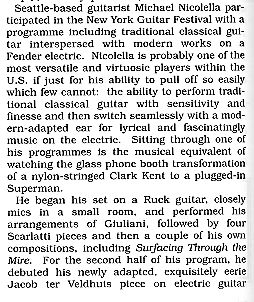
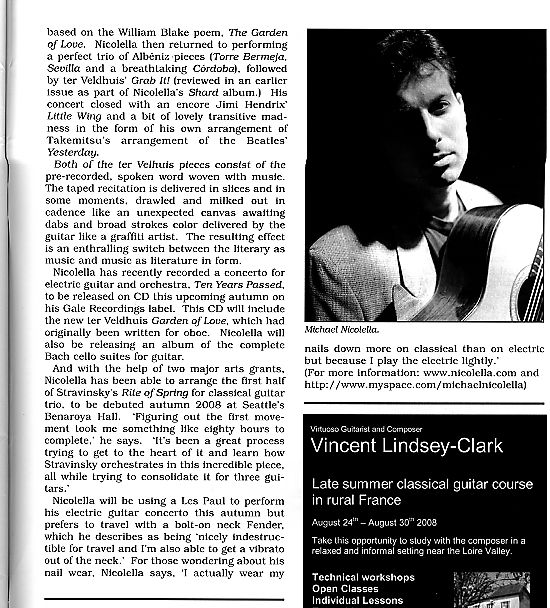
Classical
Guitar
May 2006
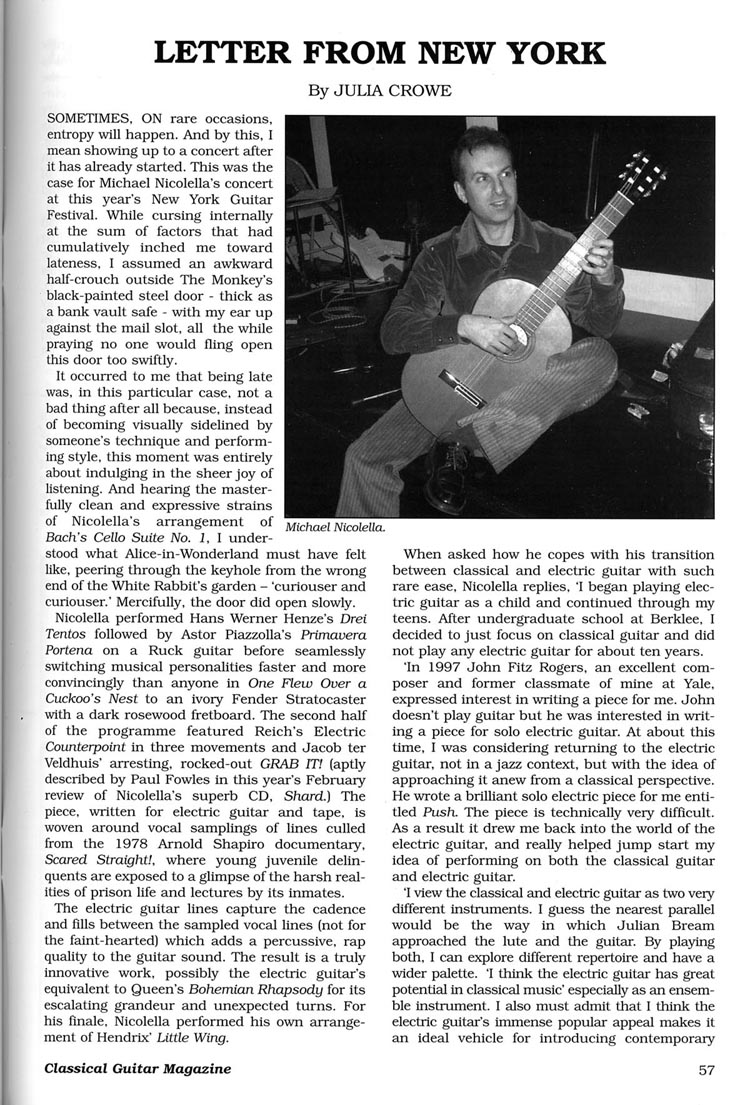

back to top
Seattle
P-I
March 17, 2006
Philippa Kiraly
"Acoustic or electric, it's all
classical with versatile Nicolella"
Like so many 12-year-olds, Michael Nicolella hankered after an
electric guitar. He already was learning acoustic guitar, but the
lure of playing in rock bands with his buddies was too strong. He
discovered jazz, then went to Berklee College of Music in Boston,
where he intended to make jazz guitar his career.
But something happened along the way. At Berklee, he discovered
the chamber music of composers like Bartok and Stravinsky."I really
fell in love," he says. "We were required to study conducting and
traditional harmony, but they were not a main part of the
curriculum." They became so for him. He set aside his electric
guitar, planning to study only classical guitar.
Fast forward 10 years, after a master's degree at Yale, and
Nicolella, now a seasoned classical guitarist, was asked if he'd play
electric guitar again."I pulled it out of the closet," he says, "and
revisited all that stuff. That was eight years ago."
Now Nicolella is known for playing both instruments, mixing them
in performance, and for his own compositions, always from a classical
standpoint.
For his performance at Nordstrom Recital Hall Saturday night,
he'll stick to acoustic guitar at the request of Seattle Classic
Guitar Society, which is presenting him. He's playing an eclectic
program of music, new and old, familiar and not. Nordstrom Recital
Hall "is beautiful for guitar," he says. The soft tones are clear,
and every note is audible.
Nicolella will play his own music as well as Bach, Albeniz,
Rodrigo, Piazzolla and Henze at 7:30 p.m. Saturday at Nordstrom
Recital Hall. Tickets are $22-$28 at 206-297-8788.
back to top
Guitar
Review
Spring 2005
Issue #130
this issue of Guitar Review included a CD, half of which was
devoted to some of Michael's compositions for solo guitar
by Stephen Griesgraber
You‚ve announced on your website that you plan to release
a new recording this year as a stylistic follow-up to 2000's Push.
Have you chosen your repertoire yet? Is there an overall concept?
Will you again be including works for electric guitar alongside
classical guitar pieces?
Yes, the CD is finished and will be released in April. Like the
Push CD it is an eclectic mix of contemporary classical music for
guitar (including two pieces for electric guitar and tape). I
programmed the CD so that every other piece is for solo classical
guitar. There are several pieces of mine including a concerto for
classical guitar and orchestra (performed with the Northwest Symphony
Orchestra). There are some excellent works written for me by other
composers and a couple of modern gems of the repertoire: the title
track- Elliot Carter's Shard and Steve Reich's Electric Counterpoint.
I actually made my own tape part for Electric Counterpoint a few
years back and have played it in concert dozens of times. So, it was
nice to revisit it and record it anew. I "orchestrated" it for a wide
variety of guitars - electric solid bodies, arch tops, classical,
steel string acoustics, and electric bass.
Many classical guitarists have taken up (or returned to)
electric guitar as their primary instrument, particularly those
interested in the contemporary musical words of minimalism,
post-minimalism, and related genres. You seem to inhabit this world
while devoting equal time and interest to traditional classical and
contemporary classical guitar repertoire. How have you approached the
exploration and development of these varied interests within a single
concert and recording career?
I certainly view the two as separate in terms of approach,
technique and repertoire. But I also feel that the two are
complimentary in that each has its own unique attributes and
strengths. With both the electric and classical, I feel that I have a
wider palette - more options. Although I still think of myself first
and foremost as a classical guitarist. There are just some goals that
I can best accomplish on the electric. I guess the best analogy would
be the way that Julian Bream approached the lute and the guitar
simultaneously.
Many composer/performers do not maintain the large repertoire
that you do, has your impulse to compose always been parallel and in
equal measure to the interest in the standard literature?
On the new recording there will be the fore mentioned concerto as
well as two solo pieces of mine. I have always composed and the
interest has been equal to my performing; though I must admit that
the time devoted to each pursuit is definitely lopsided in favor of
performance. There are times where I may go several months without
composing (especially when my concert demands are greater) but I'm
ALWAYS practicing. In addition I tend to compose very slowly. Even in
periods when I may not actually be writing, I am still thinking about
composition projects. Right now I am beginning work on a new concerto
for electric guitar and orchestra which was commissioned by
4Culture.
I really view myself as a composer/performer. Not just in the
sense that most of the works I write include guitar and that I often
perform them myself, but also in that my skill as a composer
definitely informs my performing and interpretive activities and vice
versa. Also, I think that there are certain concerns I have when
writing for guitar that a non-guitarist composer would not have (and
that I certainly do not have when writing for other instruments).
However, as a performer, my own music makes up only a small part of
my repertoire. There are other composers whose music I perform more
frequently than my own - Bach for instance.
Have you studied composition formally? How do you approach your
composing?
While both my undergraduate and graduate degrees were in guitar
performance, I also studied composition as well. Jonathon Berger,
Martin Bresnick and Tom McGah were three composition teachers who
were very helpful. Although I only studied a semester with each of
them. I think, for the most part, many composers are, to a great
extent, self-taught and I am probably more so than most. For example,
I would say that, by far, the foundation of my skill as a guitar
composer was formed by the years spent discovering and interpreting
the classical guitar repertoire. And I never studied orchestration
formally, so before I wrote my first concerto I just spent hours and
hours poring over scores and recordings. I think that was the best
instruction I could have had - analyzing how say Stravinsky or
Takemitsu or Debussy achieved their results.
I think my approach to composing probably differs from many
guitar-composers. I usually do not write with a guitar and very few
of my initial ideas come from improvising on the guitar. Most often I
come up with and develop my ideas away from the instrument and will
just use the guitar to occasionally check specifics. Consequently,
when I then learn to play one of my own pieces, the process is really
no different than learning a piece of standard repertoire that I am
only familiar with aurally. And, I find that, as in the case of
learning a new work written for me by another non-guitarist composer,
there are then usually some changes which need to be made to make the
piece more playable and/or effective.
back to top
The
State
(Columbia, SC)
Between Britney and Bach
Southern Exposure series showcases a wider world of music
Friday, Nov. 14, 2003
By T.D. MOBLEY-MARTINEZ
Staff Writer
Bach. Beethoven. Haydn. Mozart. Handel. You probably know those
names, even if you couldn't hum a note of their work. But how about
these: Reich, Piazzolla, Andriessen or Brouwer?
Not familiar with these composers? The Southern Exposure New Music
Series - which features contemporary classical work - wants to fix
that.
"I think when people think about music, the only thing people know
- the only thing available to them - is either classical music
created by mostly dead composers or pop music," says John Fitz
Rogers, an assistant professor of composition at the University of
South Carolina and artistic director of the Southern Exposure series.
"There's a whole world of music that isn't Britney Spears or Bach,
but is meaningful and can touch people.
"That's at the heart of Southern Exposure Series."
Tonight, virtuoso guitarist Michael Nicolella kicks off the
series' season with a mixed program - both acoustic and electric
guitar, contemporary classical and, well, straight-up classical.
"Remember," Nicolella says, "until the 20th century, almost all
the classical music that was performed was contemporary. If you went
to a concert, you would in all likelihood be hearing pieces which had
just recently been composed, many times performed or conducted by the
composer himself."
That doesn't happen much now, though. Today, most philharmonics
can't risk ticket sales by programming composers without built-in
name recognition. That's why you'll see warhorses of the repertoire
like Beethoven's Fifth heavily seasoning most orchestra programs.
"With the voluminous proliferation of fine recordings," Nicolella
says, "it gets harder to justify going out to hear the local symphony
play Beethoven's Fifth when you could stay home and listen to your
favorite Karajan recording.
"I think that, especially as the older generation of concertgoers
die off, orchestras and concert series will be forced to look towards
more creative programming, which would naturally include contemporary
music," he says. "The baby boomers grew up with rock music and would,
in all likelihood, relate to - and enjoy - a work by, say, Steve
Reich or Louis Andriessen more than the 1812 Overture."
Exactly, says Fitz Rogers, who, with the then-new dean of the
school of music, Jamal Rossi, and others from the music department,
cofounded the series in 2001. From the beginning, the series has been
a stage for students, faculty and guest artists like Nicolella.
Early on, the free concerts could hardly fill half of the roughly
200-seat recital hall. "Now we regularly fill the concert hall. On
more than one occasion we've had to use a second room with a video
feed."
If they can get you in the audience, Fitz Rogers says, they can
hook you.
It's a rich repertoire, sure. But it's also one steeped in
influences that anyone with a car radio and a daily commute can
relate to.
Jazz. Rock. Gospel. Folk. Music of our time, says Fitz Rogers, who
also is a noted composer.
No one, it seems, works in a vacuum. Even the long-dead composers
that headline the programs of the average orchestra concert borrowed
liberally from popular music of the day.
"With the complete pervasiveness of popular music in today's
culture, I find it hard to believe that a composer would not be
affected and influenced by some form of popular music," Nicolella
says. "In my completely unbiased view, I think that the two works
John Fitz Rogers wrote for me -'Push' and 'Transit' - are good
examples of complex classical works which completely and
unapologetically borrow from the rock vernacular."
Nicolella will perform "Push" tonight.
"My feeling," Fitz Rogers says, "is if classical music doesn't
continue to grow and embrace contemporary writing and music that is
not mainstream, it will die. It will become a museum. I don't want it
to because I write music and I want it to be '.'.'. a living
tradition."
back to top
The
Seattle Weekly
August 30, 2001
By Gavin Borchert
"Classical Between the Cracks"
A local six-stringer thrives between the genres
(This article appeared as a preview to Nicolella's concert at the
Bumbershoot Festival in Seattle)
Bumbershoot's always had an erratic relationship with classical
music. But it does have one strength: Bumbershoot provides a home for
musicians who prefer working in the gray areas between genres -
explorers for whom a cut and dried label like "classical" would be
too limiting. Seattle guitarist Michael Nicolella grew up with rock
and never left it behind even as he excelled in classical guitar
studies at the Berklee School of Music and at Yale. His hour-long
recital will be half acoustic, half electric, with a couple of
centuries of repertoire represented, from a little 19th-century
dessert piece by Fernando Sor to a new work of his own, "Surfacing
Through the Mire."
Some of the works on his program will draw from both worlds, like
the tango explorations of Astor Piazzolla; some will resemble a funky
toccata like "Open Up Your Ears" by Portland's Bryan Johanson. Steve
Reich's "Electric Counterpoint" for multiple guitars (Nicolella plays
one part live against his own prerecorded performances of the other
parts) is a landmark of the concert -music-for-electric-guitar
repertory, just as Jimi Hendrix's "Little Wing" epitomizes the rock
guitar-god tradition.
Nicolella, like most classical guitarists, is a great friend to
contemporary music, always searching for, and asking for, new work.
On his desk now, waiting to be learned, is a new piece by the
Degenerate Art Ensemble's Joshua Kohl. Another commissioned piece by
sonic saboteur Chris DeLaurenti is in progress. For his Bumbershoot
recital Nicolella will also play "Eleven" by Tom Baker, a guitarist
and skilled colorist with an impeccable ear for the instrument's
sonic and expressive possibilities.
Nicolella recently completed a guitar concerto supported by a
grant from the King County Arts Commission and is shopping it around
to local orchestras. He's also looking ahead to a Benaroya Hall
concert next spring; he plans to include, as usual works written by
and for him for both electric and acoustic guitar, as well as some of
his own transcriptions of Bach cello suites.
back to top
Milwaukee
Journal Sentinel
Friday, May 5, 1995
By Tom Strini
Journal Sentinel music critic
"Classical guitarist bids adieu"
Michael Nicolella to give final concert before he, wife head to
Seattle
At 8 p.m. Saturday, classical guitarist Michael Nicolella will
begin his last concert as a Milwaukeean.
Nicolella, 31, came to town four years ago to be guitar instructor
for both the Wisconsin Conservatory of Music and Appleton's Lawrence
University. He's leaving because his spouse of six years, painter Ann
Gale has landed a plum job on the art faculty of the University of
Washington, Seattle.
Gale, 29, has had a temporary appointment at the Milwaukee
Institute of Art and Design; her current show at the Dean Jensen
Gallery has sold out.
"Four years is a long time for us to be anywhere," Nicolella said
in an interview at the couple's spacious old townhouse in Walker's
Point. "We were starting to get too comfortable here. it's not good
for artists to be too comfortable."
"I love teaching," he said, "but I'm just drained. When you spend
all that time trying to make other people's playing better, it's hard
to come home and spend another five hours working on your own. I felt
that I was making progress in my own playing only in the
summers."
Taking Chances
I haven't heard Nicolella play in a couple of years. Back then, he
was in complete command of some of the most difficult music in the
repertoire. His playing was immaculate, lucid, intensely present.
It's hard to imagine him getting better, but possible to imagine him
changing his style.
"I'd like to think I take more chances now," he said. "I'm more
willing to just play the way I feel and not be concerned about
dropping a few notes. If you're too careful about things you don't
grow."
Nicolella will not seek a teaching job in Seattle. "I'm at a point
where I'd like to play 50 or 60 concerts a year, not a dozen," he
said. "There's no way you can hone your craft playing a dozen
concerts a year."
Amazingly, Nicolella knew almost nothing of classical music until
he got to college. He grew up in a non-musical household in suburban
Providence, RI, which then had no classical music radio station.
"We had maybe three records in our house," he said "One of them
was 'West Side Story.' I liked it a lot."
Catches the Jazz Bug
He started guitar lessons on his own initiative at age 10.
A cousin with a good record collection started giving him
albums-Hendrix, Led Zeppelin, Leo Kottke, anything where the guitar
was prominent, and all kinds of jazz. Nicolella's interests went in
that direction.
"I wanted to be the next Pat Metheny," he said referring to the
jazz guitar virtuoso.
He went to college in Boston - not at the New England
Conservatory, but at the Berklee College of Music.
Boston, of course, had classical music stations and a rich concert
scene. And Berklee puts its students through rigorous cycles of
theory and counterpoint based in the European classical
tradition.
"I started listening to Beethoven and Bartok and just falling in
love with that music," he said. "And I started studying classical
guitar."
Decision Time
Nicolella graduated from Berklee at age 20 and faced something of
a jazz vs. classical crisis.
"For a while, I spent two hours a day practicing jazz, two hours
on classical and two hours composing. Even at Yale I had a jazz
quartet."
He's barely had his hollowbody archtop guitar out of the case
since coming to Milwaukee. -there's been no time for jazz. He's
looking forward to limbering up his jazz muscles in Seattle, partly
because he longs to play more with other musicians. Classical guitar
is a lonely, soloistic instrument.
Nicolella requires his students to play chamber music and he plays
it himself whenever he can. He'd planned to put some on Saturday's
program but it didn't work out. He will play "Toccata y Lamento" by
Roberto Sierra, former Milwaukee Symphony composer-in-residence;
Fernando Sor's "Fantasia" Opus 30; Frank Martin's "Four Short
Pieces"; F.Couperin's "La Menetou"; Nicolella's own "Variations on a
Theme of Beethoven'; and Bach's "Chaconne," from the Violin Partita
BWV 1004.
Nicolella is serious about reviving the nearly lost tradition of
the composer/classical guitarist. Last year, he was one of a handful
of winners of $5,000 Wisconsin Arts Board grants for musical
composition.
That grant notification, by the way, typified the charmed life of
this talented and hard-working couple.
back to top
The
Providence Journal-Bulletin
Friday, February 17, 1995
Classical wrapup
by Channing Gray
"R.I. native highlights a big guitar
weekend"
You can sample the guitar artistry of Rhode Island native Michael
Nicolella this weekend or drop in on an afternoon of popular hits
from 18th century France at Providence's Lippit House Museum.
Actually, this is a big weekend for guitar music. Nicolella,
now based in Wisconsin, will be appearing at the Music School
tomorrow night in a program that contains one of his compositions
along with his own transcription of the great violin "Chacconne" of
Bach.
Nicolella will be making his more or less annual swing through
Providence tomorrow. the guitarist grew up in Cranston and studied
jazz at Boston's Berklee school of Music. But he always loved
the classical end of the repertoire and gradually shifted over to
classical guitar, trying to make a go of it in a crowded market.
On the phone the other day, Nicolella acknowledged that the
competition is stiff. But he has put out a CD and is hoping to
have another disk of 20th century music out soon.
Contemporary guitar music may not sound like a big seller, but
Nicolella, who teaches at a couple of schools in Wisconsin, feels
that a lot of important music is being written these days - by major
composers, he adds - and that it's vital that someone champions the
cause.
Tomorrow night he'll be opening his recital with a "short but
aggressive" toccata by Roberto Sierra, written in 1987 as a sort of
homage to Villa-Lobos.
Then he'll perform his own set of variations, based on the last
movement of the opus 109 piano sonata of Beethoven, which is itself a
masterful set of variations.
Nicolella's piece is interesting in that each variation moves
farther and farther away from the Beethoven in terms of its
compositional style - working its way from a section inspired by a
Brahms intermezzo to one that takes its cue from the atonalism of
Alban Berg.
"It's sort of a work in progress'" said Nicolella. "I've
been writing and scrapping variations for it. In fact, since the
program was announced, I've written two new ones."
Rounding out the evening are scores by Francois Couperin, Frank
Martin and the prolific guitar composer Fernando Sor.
Nicolella's interest in contemporary music hasn't exactly made him
a favorite with presenters, people who usually don't like to gamble
on programs that stray too far from the mainstream. His recent
plans to include a large Luciano Berio piece on a Chicago concert was
shot down by the manager.
But Nicolella said he has had good luck with the difficult score
among audiences, especially listeners who don't have preconceptions
abut modern music. The Berio was a big hit when he played it
not long ago at a small-town Catholic college.
"I just enjoy playing music that I like" he said. "Hopefully
that comes through to the audience and they enjoy it too."
back to
top














